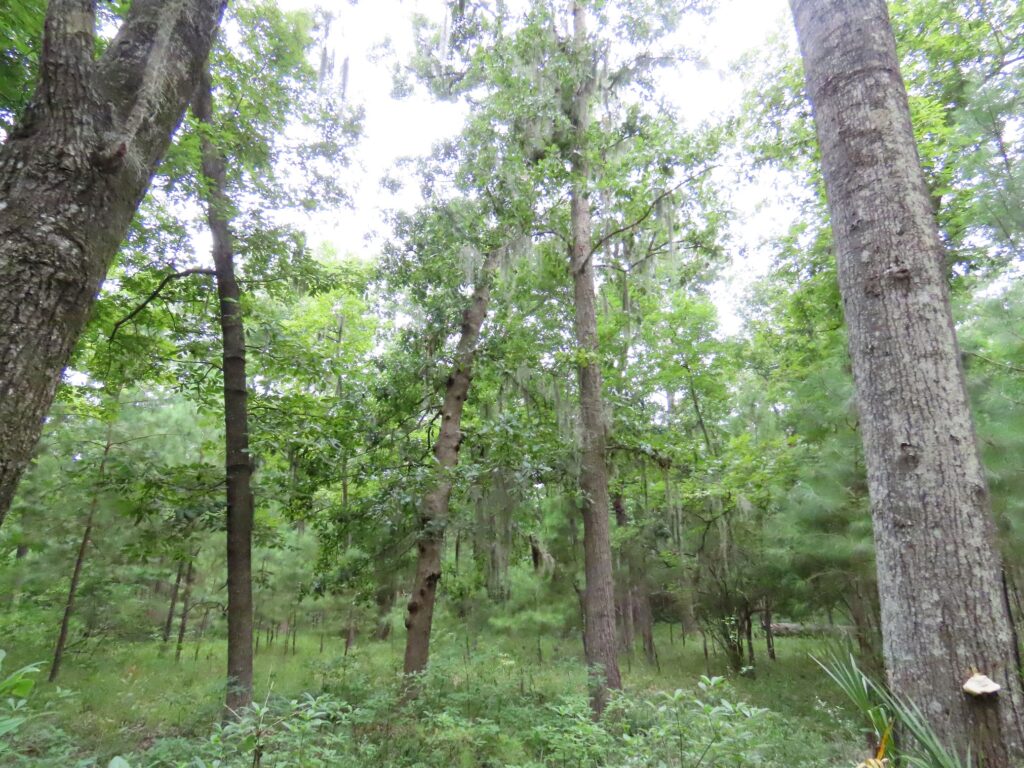

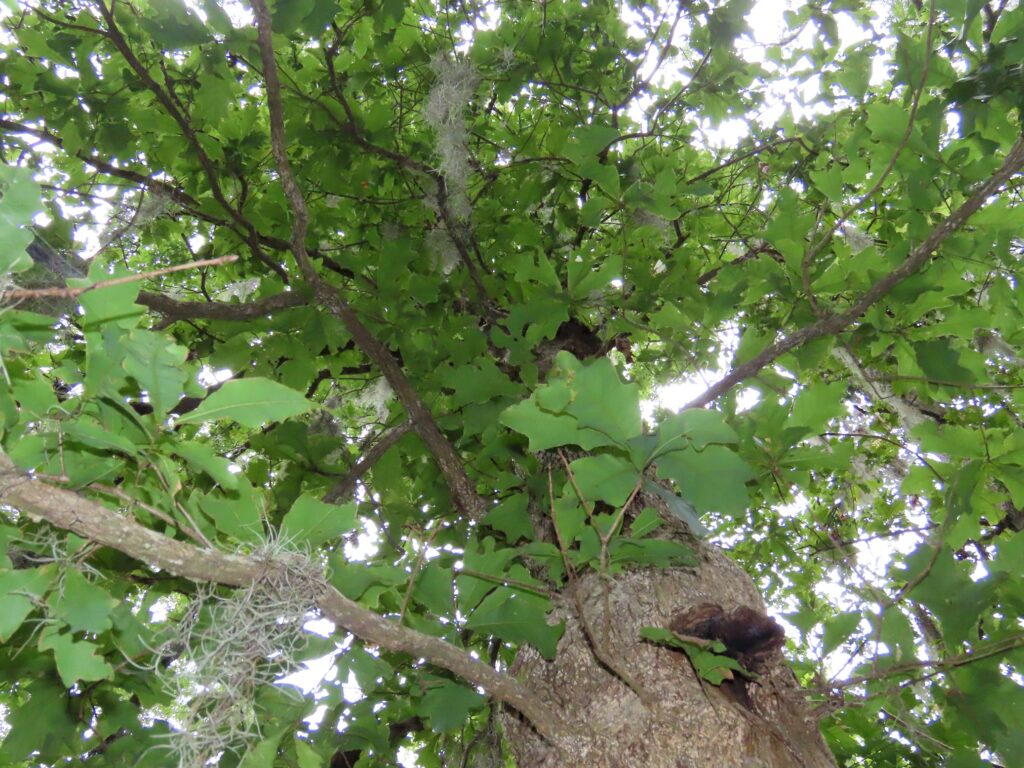
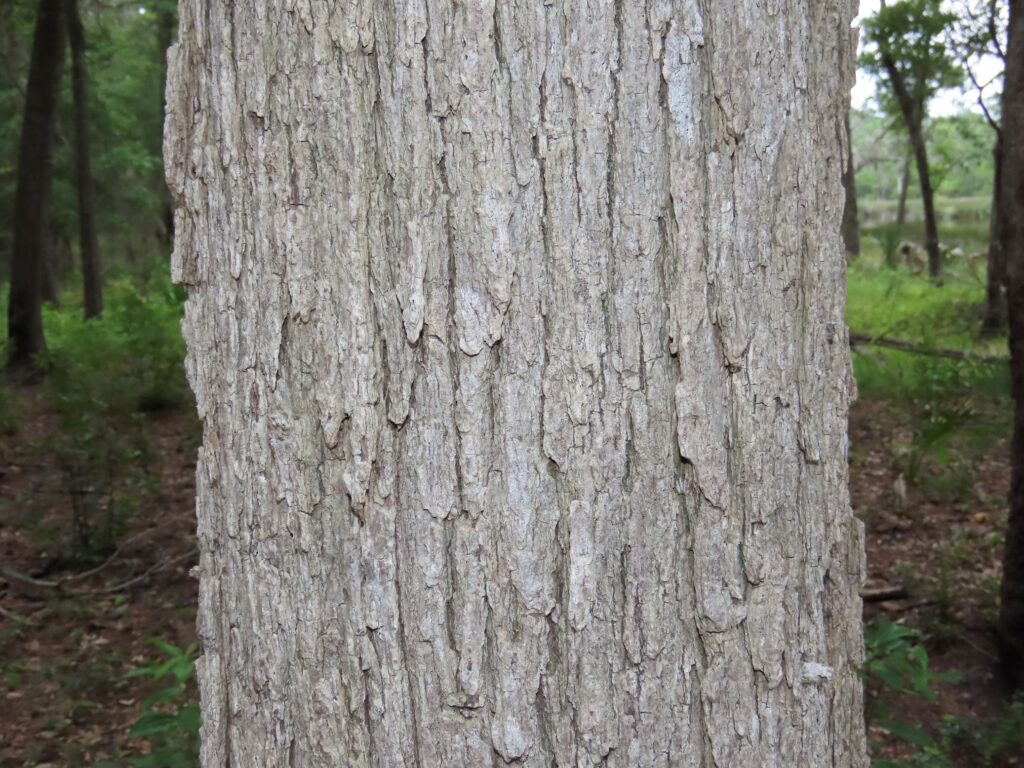
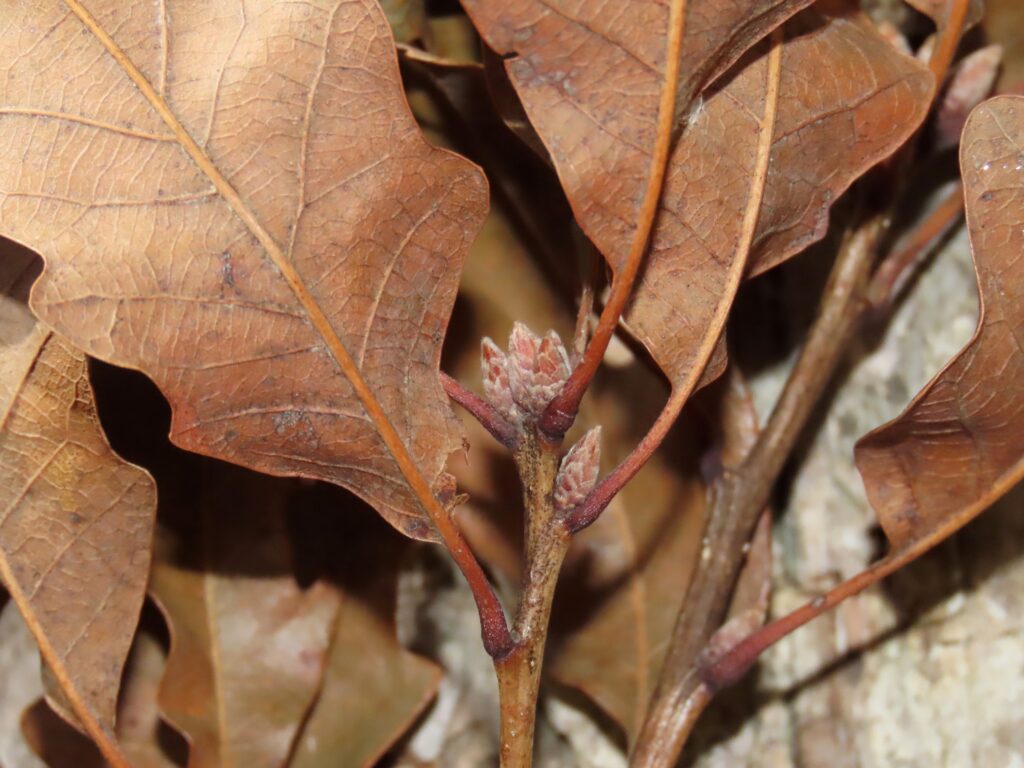
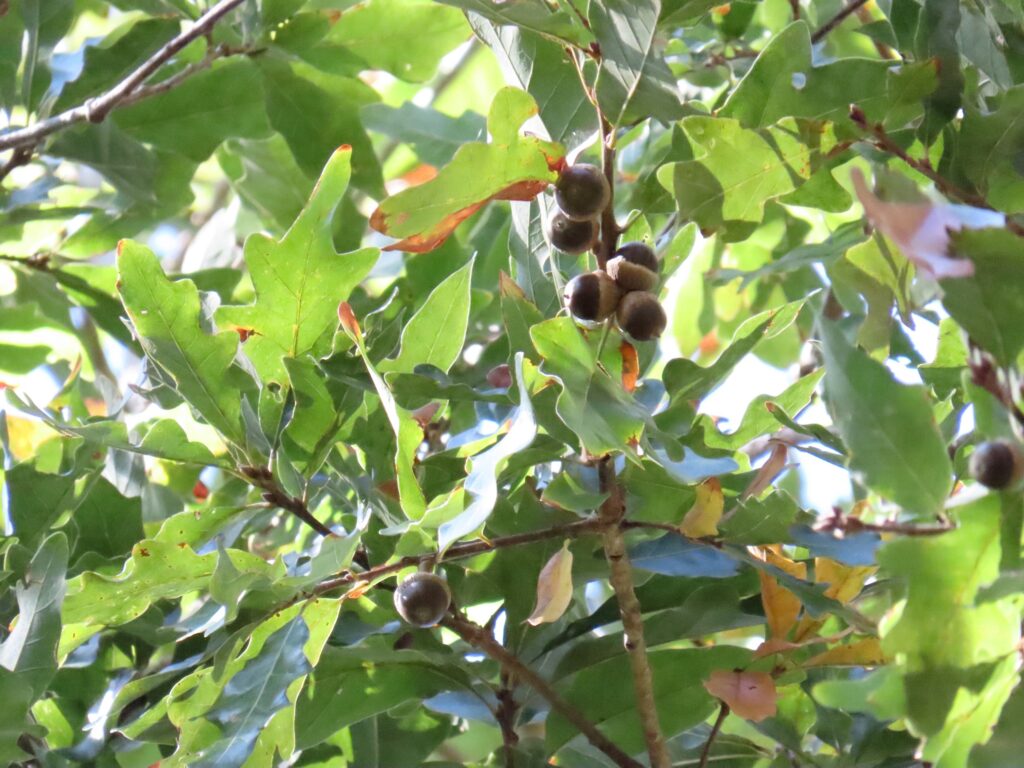
This week for Flora and Fauna Friday we have an imperiled tree that, like sand sliding off a bluff, is silently slipping away from our Sea Island landscape, the Bluff Oak (Quercus austrina).
Bluff Oak is a small oak growing to roughly sixty feet in height. Its trunk is straight and sheathed in fine flakes of platinum-white bark. Often that trunk is blemished with small burls or studded by small low-hanging limbs blending upward into a tall crown. The deciduous leaves of Bluff Oak are a rich emerald-green and feather-esque in shape. These leaves are the length of your outstretched hand but relatively narrow and pointed, with seven-or-so irregular, shallow lobes. They’re not the easiest oak to identify. Yet, their twigs are reddish brown with strongly pointed buds. This is a subtle feature that helps separate them from their closest relatives among the white oaks. Their lime-green acorns are fairly large and sought after by deer and turkeys, if the squirrel and Jays don’t claim them first.
Bluff Oaks grow in the Deep South from Mississippi to North Carolina and down through North Florida. Yet, they are known from only a smattering of trees from a handful of counties in each state. They’re most often encountered perched on a bluff overlooking a marsh or river. Here on the South Carolina Sea Islands, fertile well-drained soil in maritime fringe forests in view of the marsh and with a stable shallow water table seems to be their preferred natural habitat. But that comes with a caveat. Bluff Oaks are weird.
Very few people, if any, have a good handle on what makes Bluff Oaks tick in their natural habitats. They occupy a very narrow niche in the Sea Island ecosystem. A niche that was historically quite stable but today quite rare due to the meddling of man. You see, Bluff Oaks love to live on bluffs, with a panoramic prospect of the marsh or a view down a bend in the river. But that’s most people’s favorite place to live as well! That’s bad luck for the Oaks. Untold scores have been clear-cut for waterfront development over the last 75 years. Many of the mature Bluff Oaks still alive today are nestled quietly in people’s yards, on church grounds, near boat landings, or on old government lands along rivers. Long before large-scale residential development began sweeping through the South, Bluff Oaks were imperiled by logging and agriculture. Clearcutting for fields on fertile sands removed mature trees from all but the bluff margins. Bluff top plantation houses displaced them further. The old trees that survived on the landscape then had the stability of the shallow water pulled out from under them by ditching and diking. Drying or flooding the few trees still hanging on. Their progeny subsequently clung to cliff faces, marsh margined peninsulas, and remote islands that were too impractical to farm and which foresters found inconvenient to plant in pine. Many of the surviving Bluff Oaks were likely intentionally spared the axe, due to their compact growth and long crown making them unfit for lumber, and thus not worth the fuel to haul to the mill. Or that’s the history I at least surmise led to their near demise.
Bluff Oaks were rare to begin with, grew in inconvenient locations to access, and had little economic value. So people paid them little attention. Meaning we have a very poor understanding of what their historic range used to be. Now that there are so few left, it’s incredibly difficult to fit enough puzzle pieces together to see the full picture of their ecology. I suspect they’re a botanical relict of a bygone time. An arboreal artifact from an ancient age, likely a species that thrived before the last ice-age, compressed by climatic swings and then pushed towards the brink by our hands. The Bluff Oak’s distribution is incredibly disjointed, with tens or hundreds of miles between populations. Those populations are rarely more than a half-dozen trees. Most are just one or two trunks. Less than ten sites are known with more than ten trees. That means there is next to no gene flow between populations. Often, there are no saplings growing that can replace mature trees when they perish. They are a declining species on the path to oblivion.
But all hope is not lost! Bluff Oaks actually do well as a shade tree in coastal suburbs and developments. They even thrive when reintroduced to their natural habitats on bluffs and banks. We haven’t pushed this species off the bluff yet! There is a space for them in the modern world. We just need to lend a helping hand. Right now, there is active research underway led by the North American Land Trust, in partnership with the US Forest Service and several Arboretums, to collect acorns and scionwood from Bluff Oaks across the country. These acorns and grafts will be grown out into mature trees as living seed banks. The USFS is even starting a nursery for Bluff Oaks in SC within the Francis Marion National Forest. The acorns produced by these nursery and specimen trees will be used for conservation of the species across the Southeast.
You can help in this effort too! The most important thing this research needs help with is finding new Bluff Oak populations. Currently, only one single site in Charleston County is known with surviving Bluff Oaks. Those seven trees are standing proud today on one of EIOLT’s conservation easements, right here on Edisto Island. Which means there very well might be a Bluff Oak standing on the edge of the woods right outside your window! If you think you know where a Bluff Oak is, anywhere in South Carolina, please reach out to EIOLT with the location of the tree and take some photos of the bark, leaves, and twigs if you can. We’d love to document its location, collect acorns, and help save this imperiled species.
Bluff Oak seedlings are not currently readily available anywhere for purchase for transplantation. At least not anywhere I can find online. But I’m hopefully that, in the not so distant future, they will be. And that this handsome hardwood can once again grace the banks of Edisto Island. Waving with Spanish Moss over our waterways, shoulder to shoulder with Live Oaks and arm in arm with Edistonians.
If you’d like to learn more about this research and restoration effort, please check out the below links:
https://www.internationaloaksociety.org/content/seeking-quercus-austrina-conservation
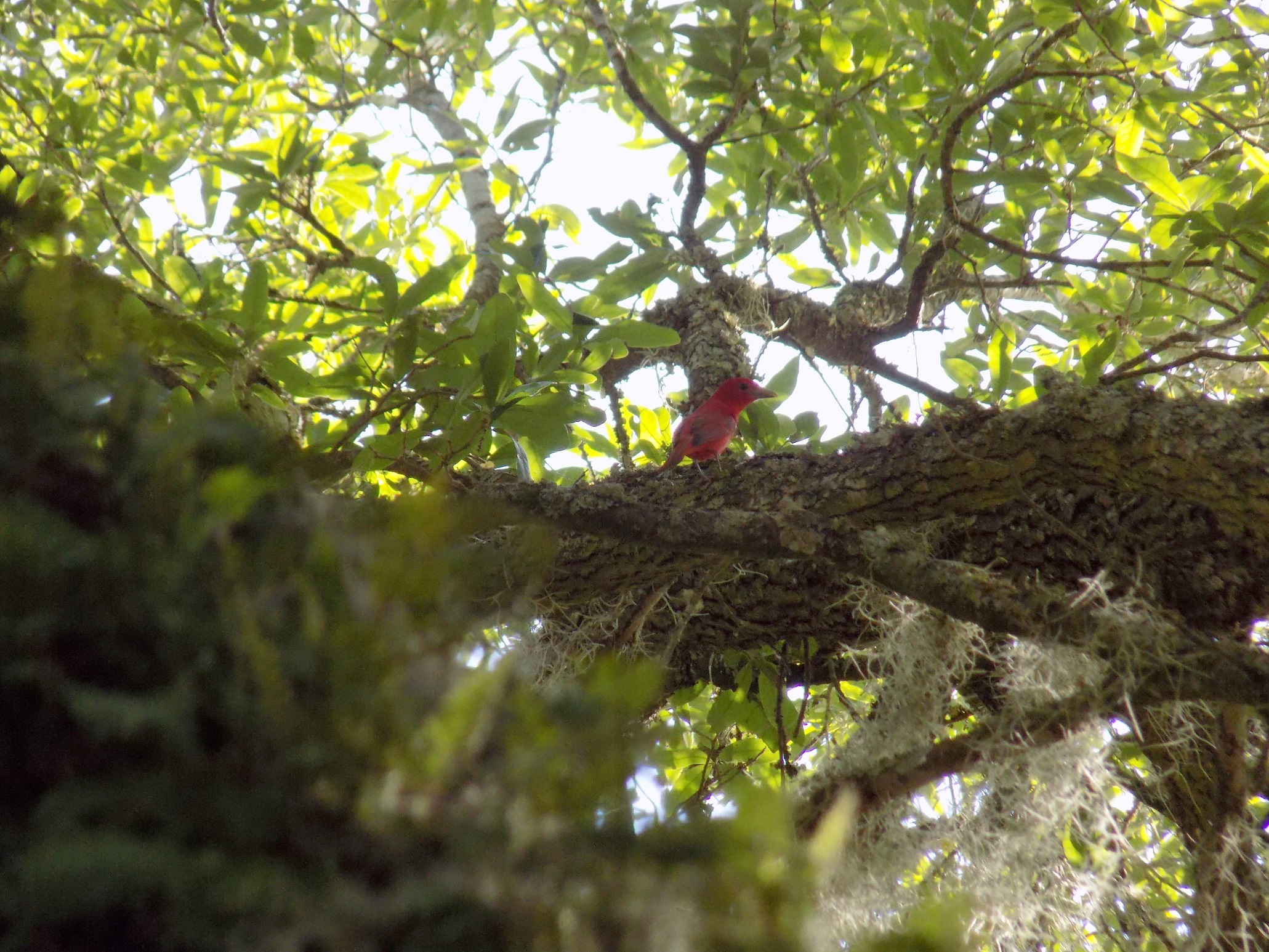
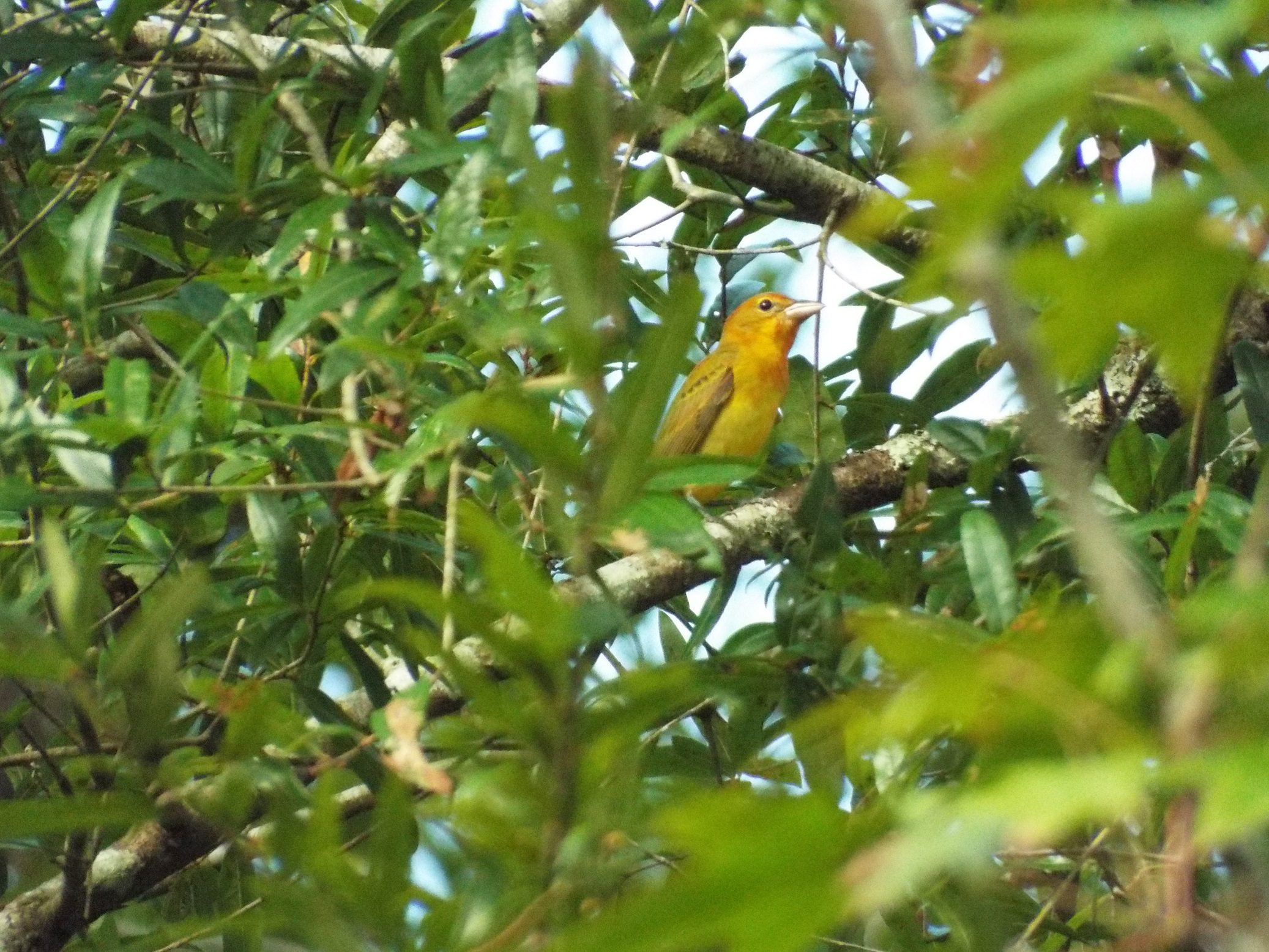
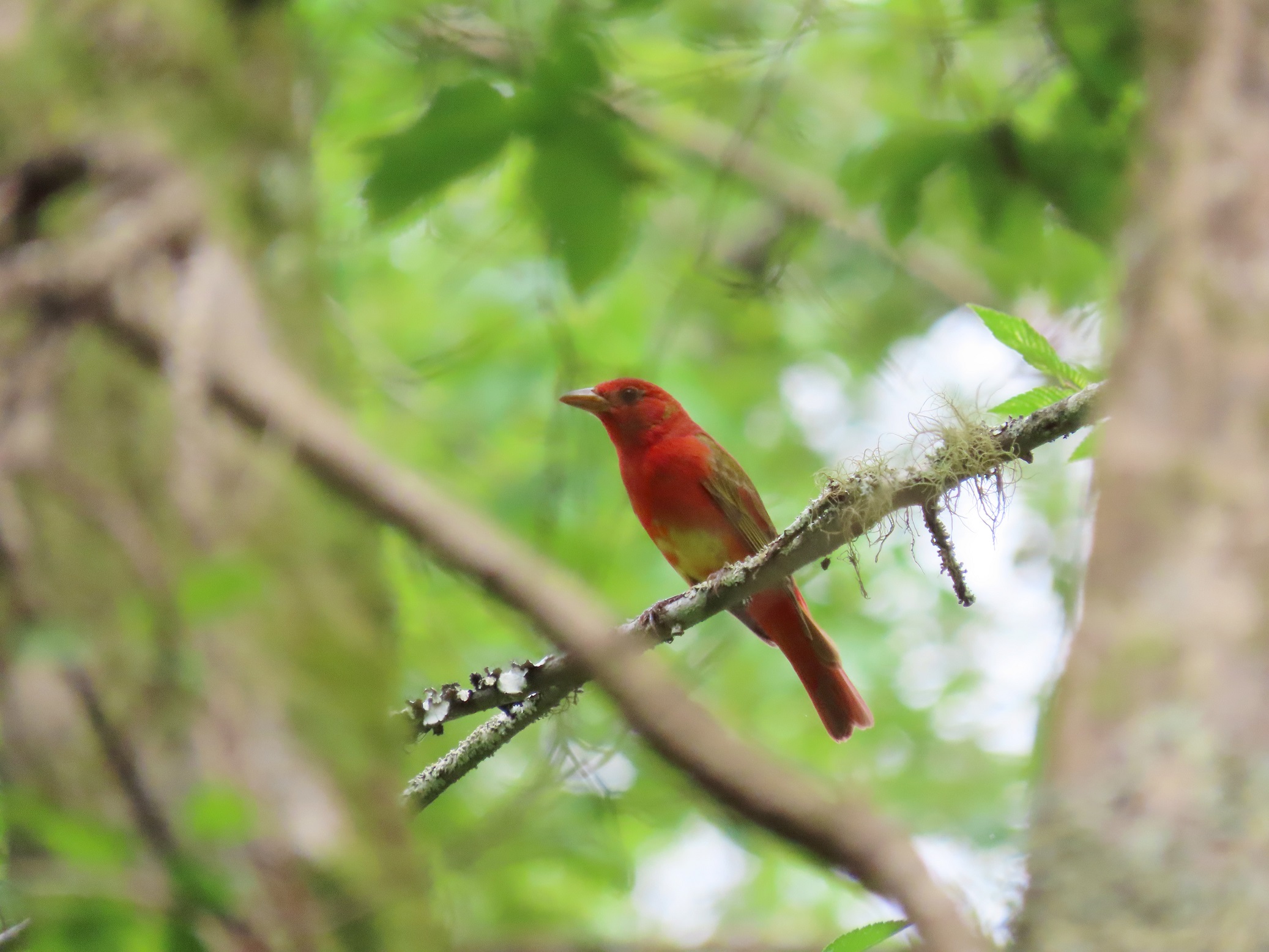
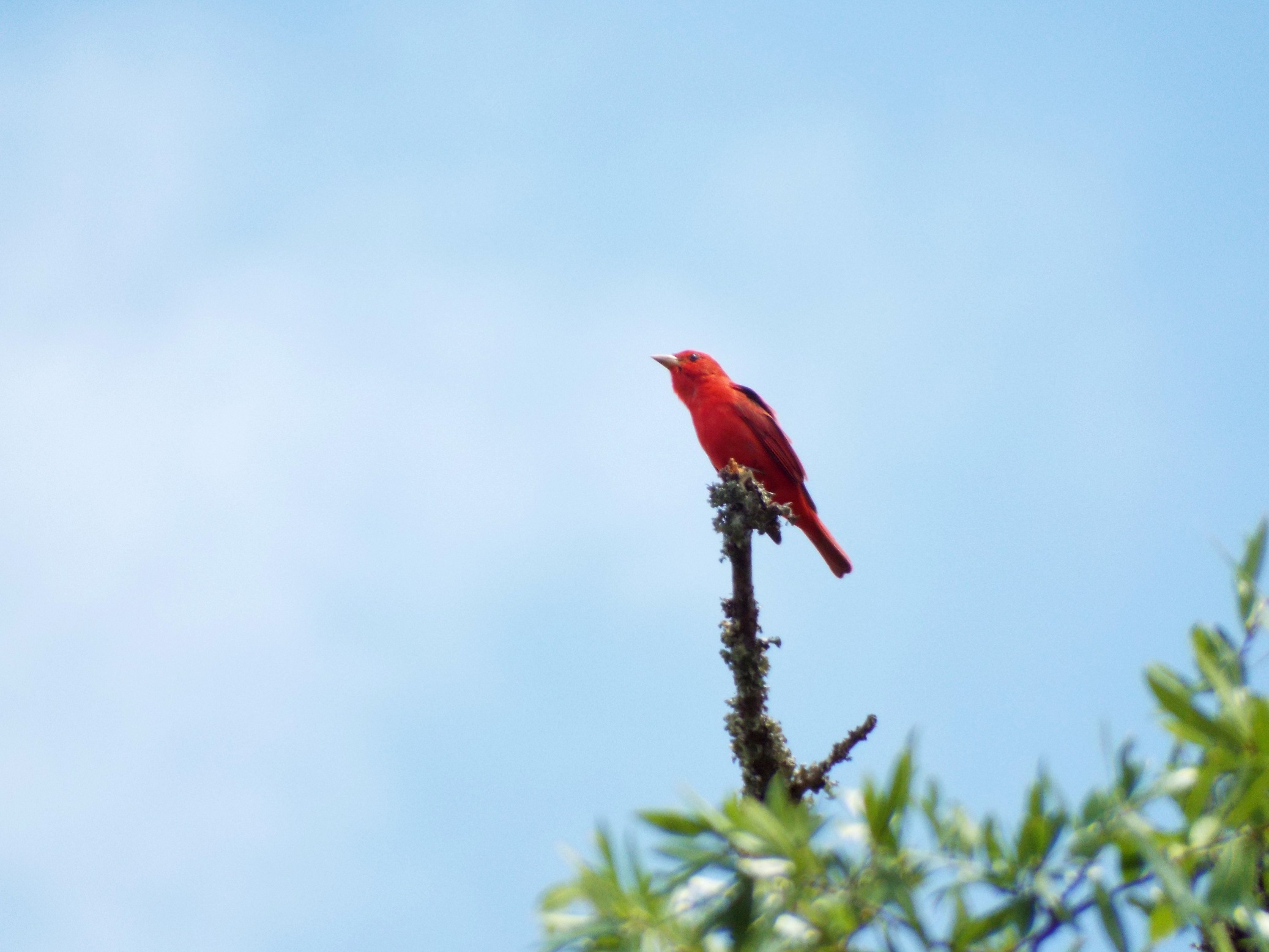
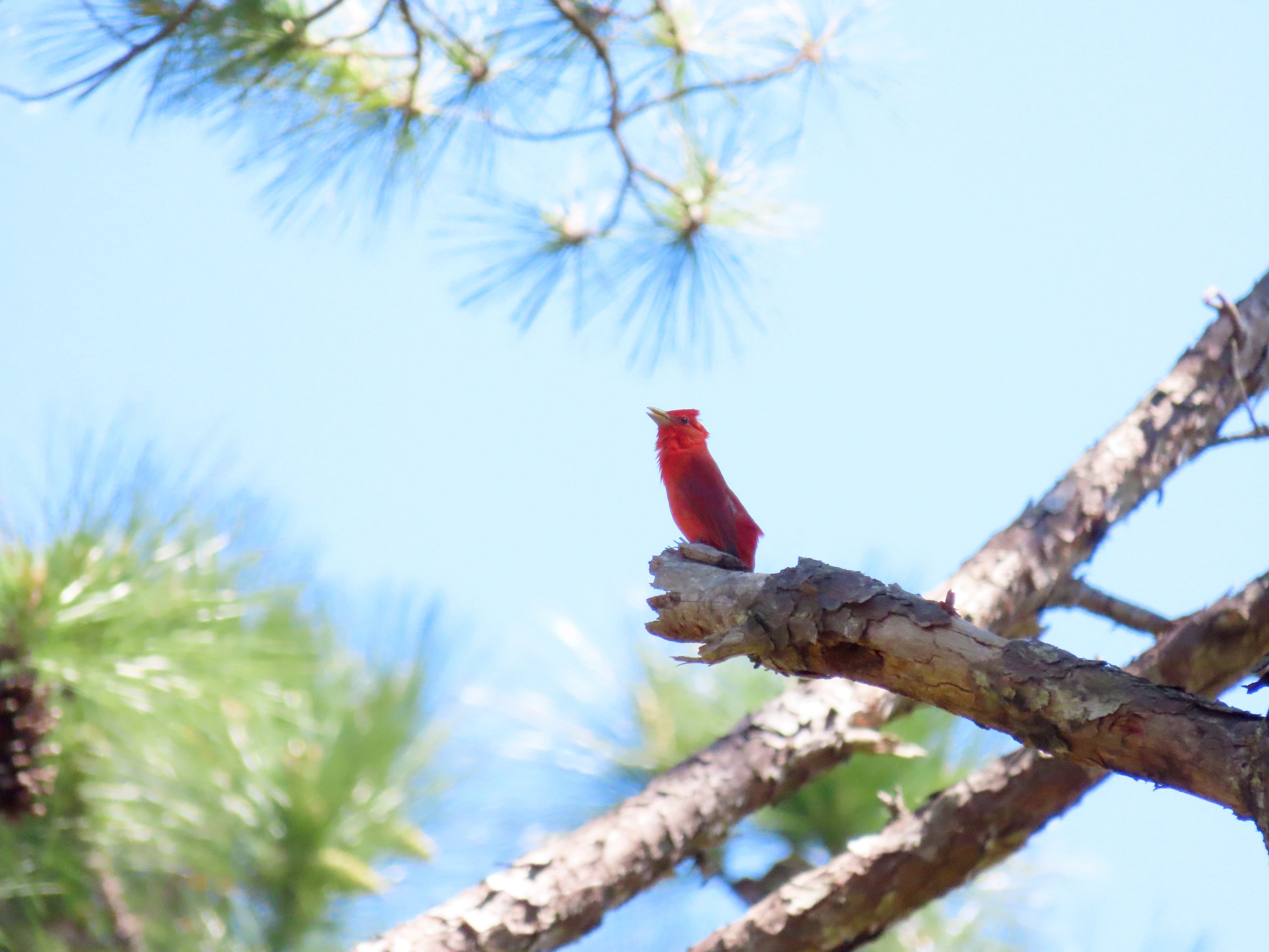
This week for Flora and Fauna Friday it’s our other red bird, the Summer Tanager (Piranga rubra).
Draw a line to a branched tine high in a pine and there you’ll find birds that shine bold of ruby and gold. With the end of winter’s cold, stepping into spring’s hold, summer’s Tanagers are pulled to the Lowcountry; they fall upon our forests once more. Summer Tanagers are part of the Cardinal family, Cardinalidae, which contains some of our most stunning songbird species. Our Summer Tanagers are no exception here. Males radiate a deep and vibrant scarlet-red across their entire body, contrasted only by beaded black eyes and a bone-yellow bill, heavy and faintly down-turned. Females are stunners too, with feathers saturated a saffron-yellow over undertones of olive-green, which shows most strongly through their wings.
Summer Tanagers spend the winter in the tropics of Central and South America. They return to the Southern United States around the spring equinox, reaching the South Carolina Lowcountry on the first week of April most years. Upon arrival, they begin establishing territories in wooded locales. They prefer patrolling open woodlands, savannas, maritime forests, field edges, and park lands. Places with wide spaced trees or an uneven low canopy. On the Sea Islands, males most often perch atop a Live Oak or pine and begin singing their own praises, a jumbled, oscillating whistle that echoes over the forest, a sonic fence to stake a claim of land. When not mending fencing or disputing borders, Summer Tanagers can be heard moving through the treetops uttering a trademark “pi-tick” call or chattering “pi-ti-tu” as they go.
Summer Tanagers are leaf gleaners and hawkers, scanning limbs and twigs for a quick insect snack but also jetting out into the air to snatch insects from the sky. They will eat a fair share of fruits too when in season. Summer Tanagers are specialized for eating bees and wasps, brazenly busting into hornet hives and ripping open wasp nests to eat their larvae or hawking bees on the wing for a honey-glazed meal. It’s not known whether they have any special resistance to bee and wasp venoms, or if they’re just fearless in the face of a free lunch.
Despite being an abundant, noisy, brightly colored, courageous killer of bees, Summer Tanagers are often hard to get good, close looks at. Like its other Cardinalid cousins, to include Grosbeaks and Buntings, they are curious but skittish creatures. Often they drop in to investigate neighborhood commotions, when Wrens and Titmice start sounding alarms, but will almost always dart out of sight if you turn your attention towards them.
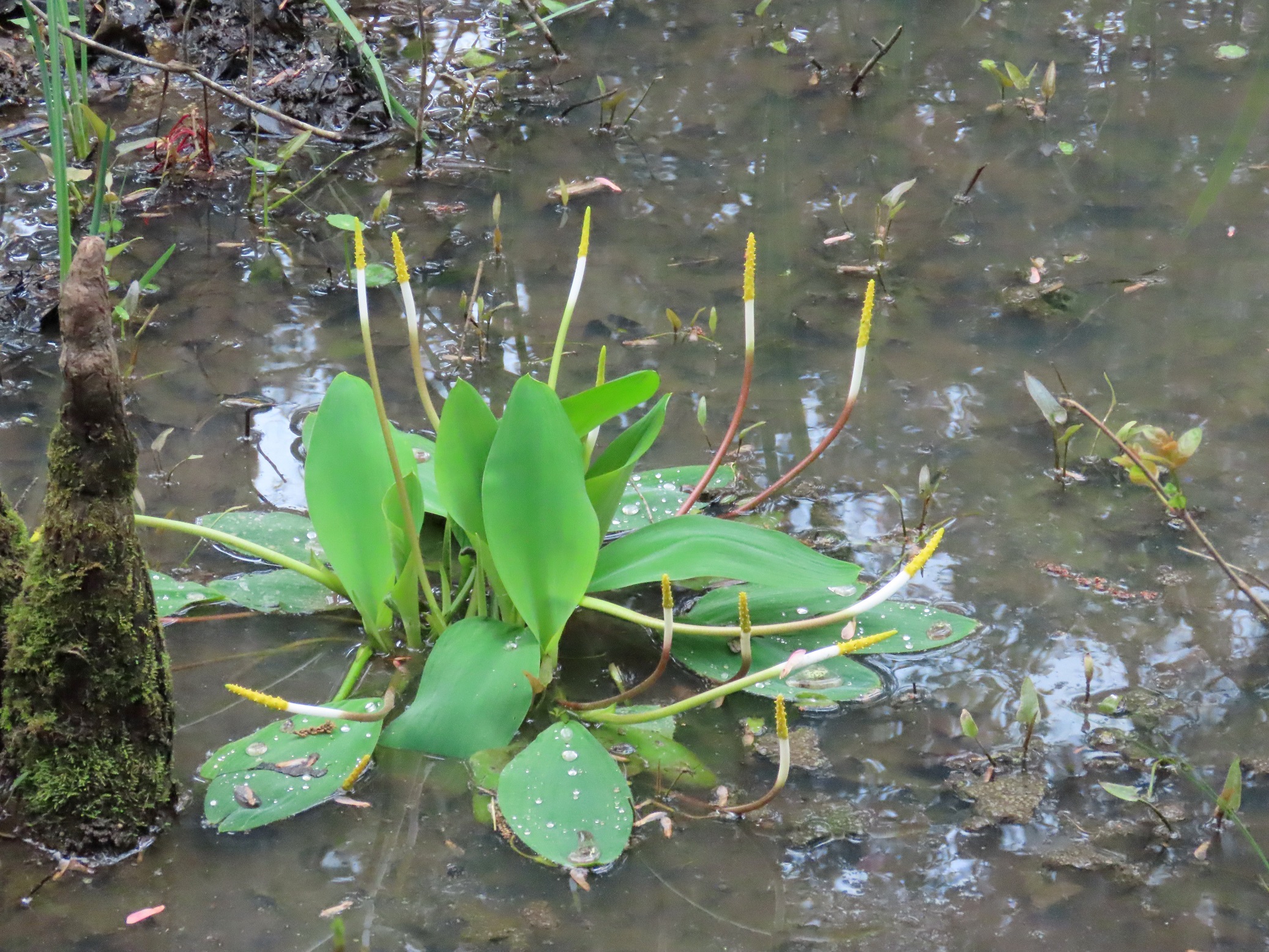
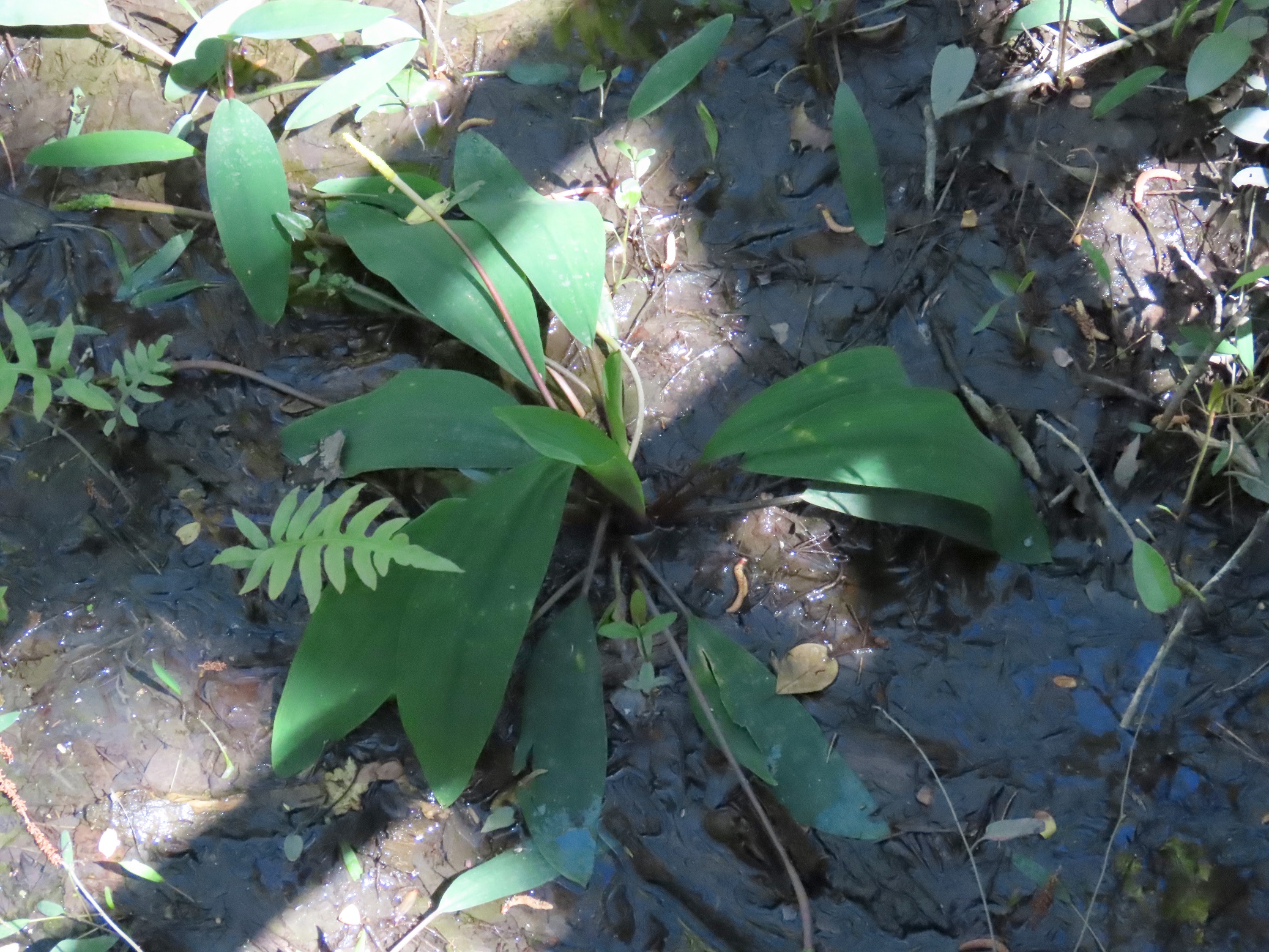
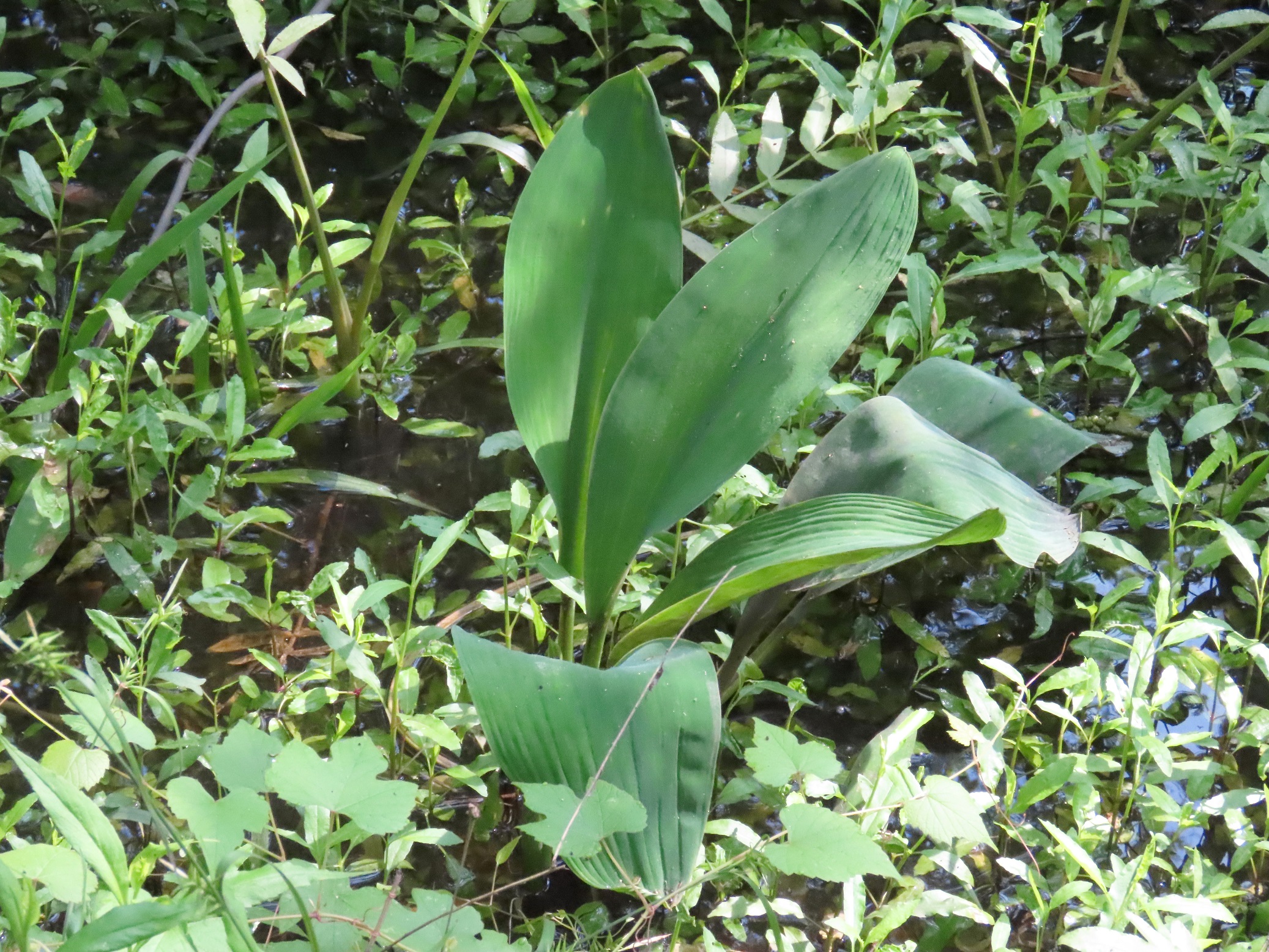
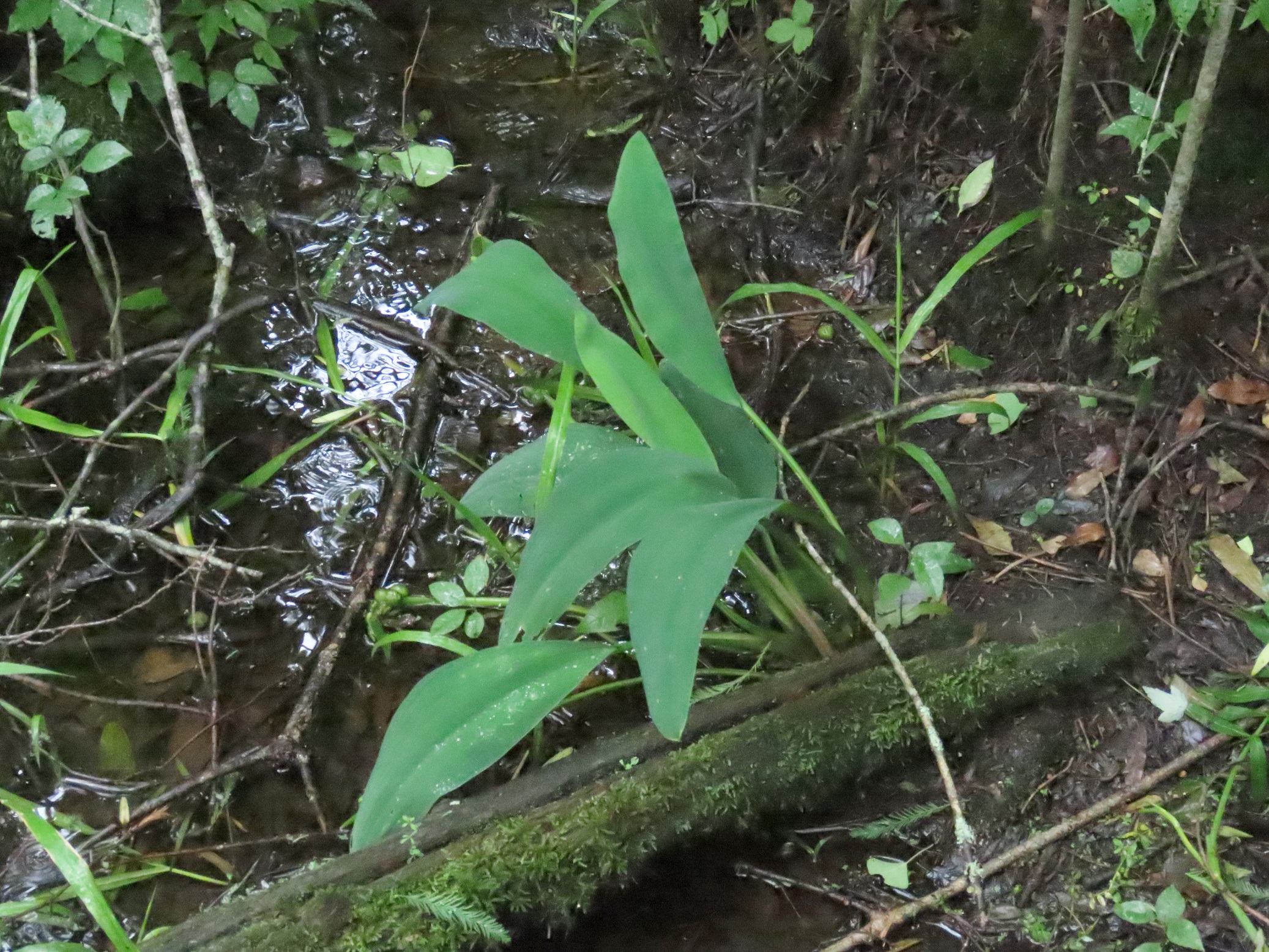
This week for Flora and Fauna Friday it’s an early to rise and always dry, wetland wildflower, Goldenclub (Orontium aquaticum).
Goldenclub is found throughout the coastal plain of the Eastern United States, from the Mississippi to Massachusetts. They inhabit bottomlands, primary floodplains, backwaters, freshwater swales, mill ponds, and other shallow and slow-moving freshwater systems. In my experience around the Sea Islands, they prefer fertile floodplain wetlands with ankle deep water and some shade throughout midday. They are perennial plants and grow most often as individual floating clumps, about two to three foot around. However, under ideal conditions, they will spread through their roots below the mucky soil to form large colonies. The leaves of Goldenclub average about a foot long, are tongue-shaped, and shaded a luxurious, deep blue-green.
That bluish color on a plant’s leaves is known more scientifically as being “glaucous”. This most often originates from a waxy leaf coating, which can be seen as a silver-lining when the leaf is viewed obliquely or in strong sunlight. This waxy coating waterproofs leaves, usually to stop them from drying out in droughty conditions or intense sunlight. So, why does a plant that lives on saturated soil in standing water need to conserve water? It doesn’t! It needs to get rid of it. The waxy coating on Goldenclub is hydrophobic, repelling water. In fact, “Never-Wet” is another common name for the plant. This hydrophobic coating combined with internal air pockets forces submerged Goldenclub leaves to buoy back up to the surface, instantly shedding any water clinging to them, so they can return to the unobstructed sunlight they need to photosynthesize. This allows them to recover from, or avoid altogether, inundation during floods and intense rains. This can smother a plant in debris if it sinks, forcing it to regrow from its roots. But our Goldenclub is weatherproofed, so it can weather storms.
Goldenclub blooms in March into early April. Its flower is one of a kind: an ivory-white stalk, finger-width, a foot or more in length, and crooked midway, that’s capped by a thumb-sized golden spike of miniscule flowers. These “golden clubs” or “bog torches” give our plant its more oft used common names. Goldenclub belongs to the Arum family, Araceae, an ancient family of flowering plants best known for their strangely shaped spike-like flowers. Arums, to include our Goldenclub, are most often pollinated by flies, beetles, and the occasional desperate bee. The flowers, once pollinated, mature into a lumpy brown-green cudgel of fruits.
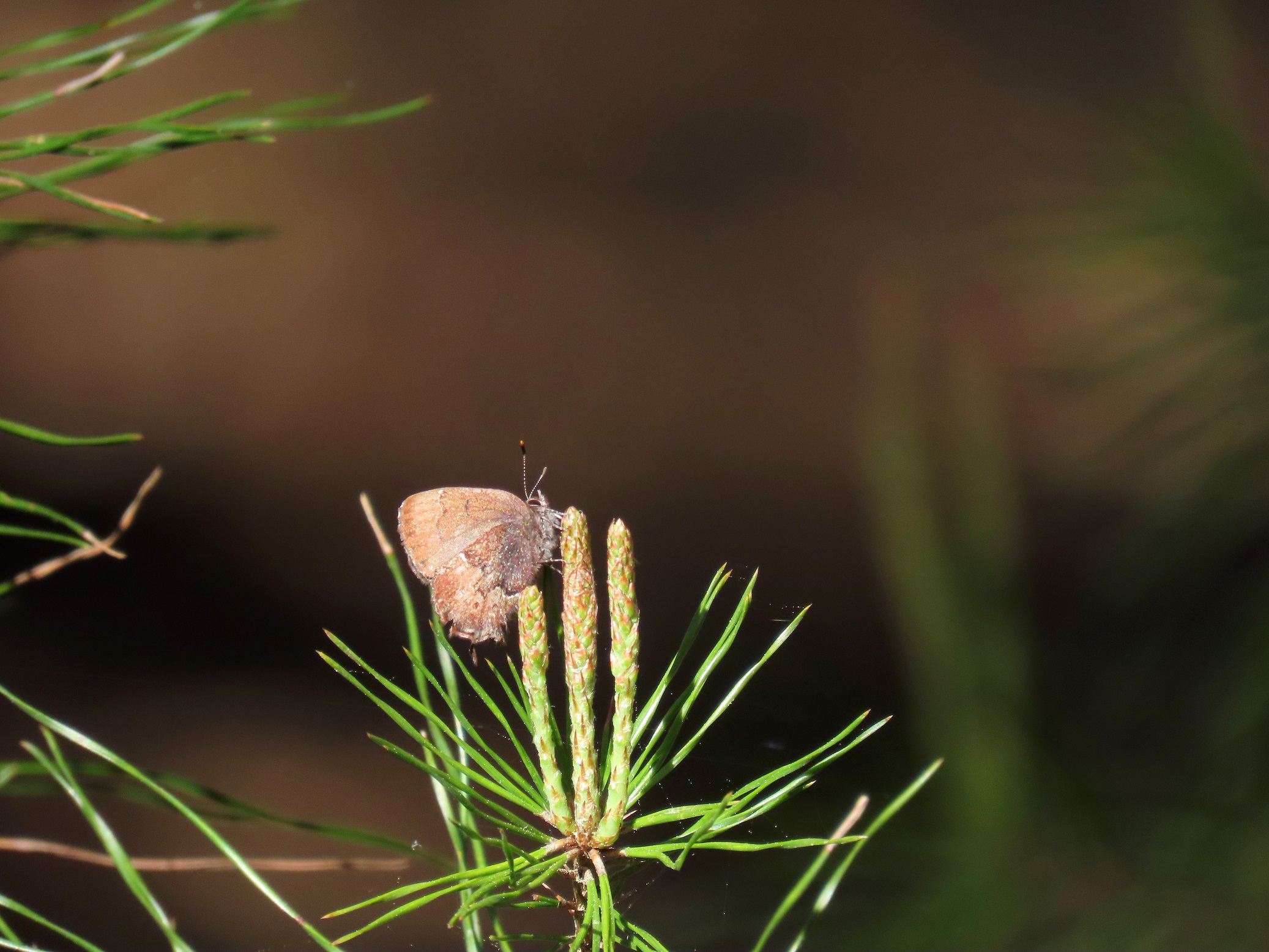
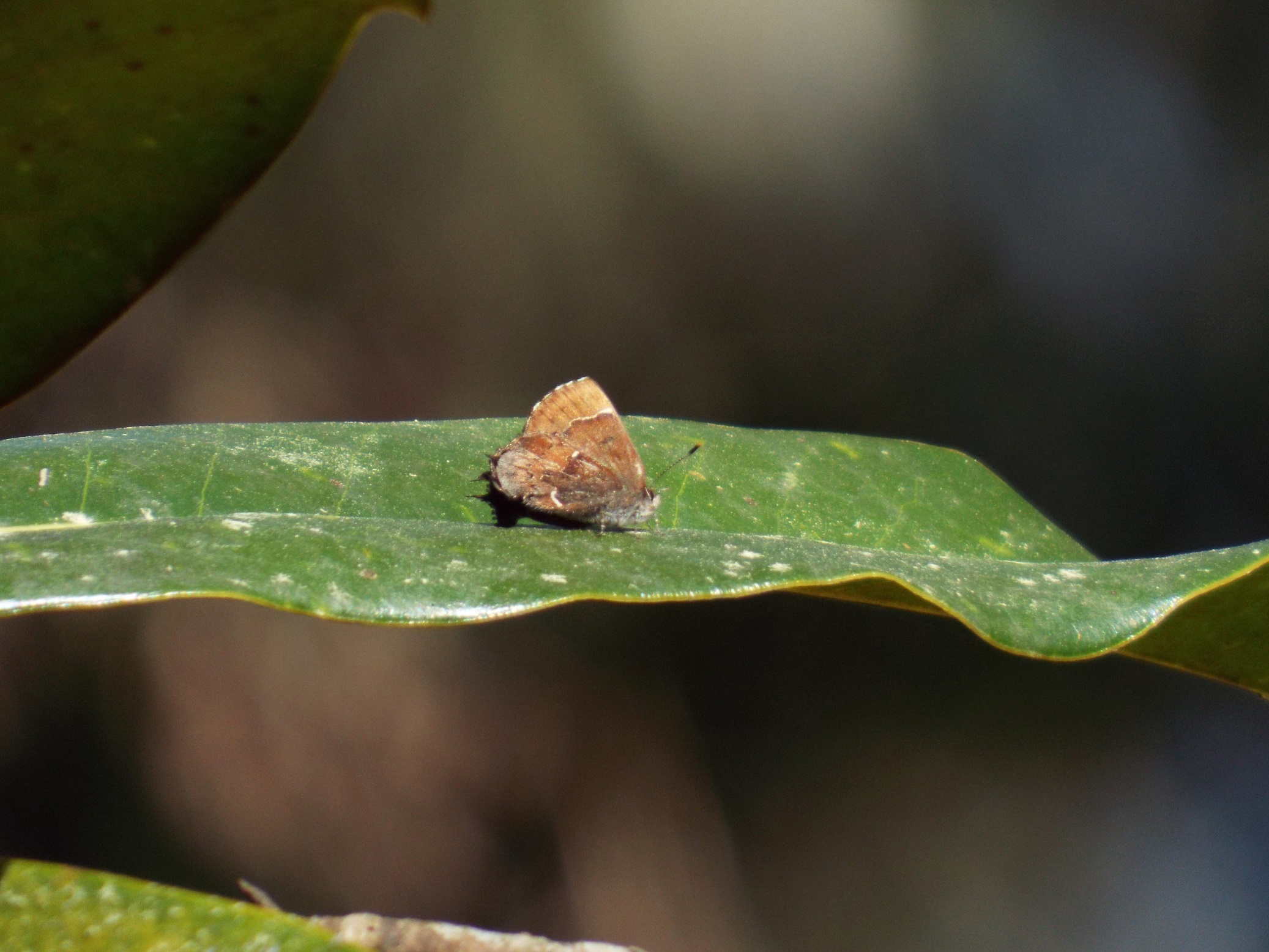

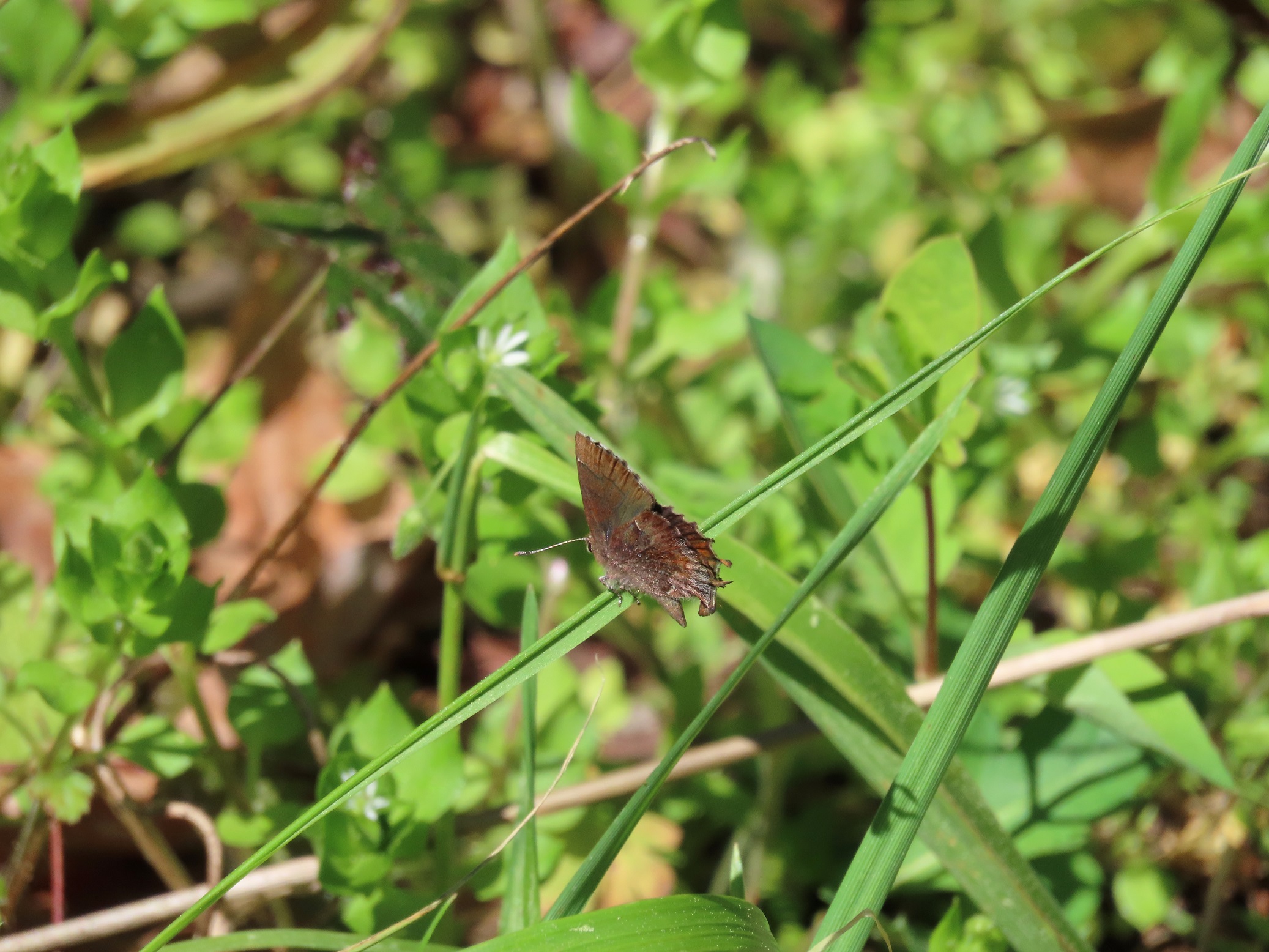
This week for Flora and Fauna Friday it’s one of our earliest butterflies of the year, an oft hard to find hardwood flutter-by, the Henry’s Elfin (Callophrys henrici).
We have six species of Elfin here in South Carolina: Henry’s Elfin (C. henrici), Juniper Hairstreak (C. gryneus), Eastern Pine Elfin (C. niphon), Frosted Elfin (C. irus), Brown Elfin (C. augustinus), and Hessel’s Hairstreak (C. hesseli). The Henry’s Elfin is our most common and widespread Elfin here in the Lowcountry and our focus for today. Yet, the Juniper Hairstreak is fairly common on the Sea Islands, although much more scarce. The Pine Elfin is also here but very seldom seen. The Frosted Elfin is a rare and endangered species specialized to wiregrass savannas. Brown Elfins and Hessel’s Hairstreaks are found only upstate.
Elfins are butterflies in the Gossamer-Wing family, Lycaenidae, a diverse clade of small, close winged butterflies. This family is best known in the United States for holding the Hairstreaks and Azures, both groups are often a pale gray below but blazoned above with a brilliance of iridescent blue. Elfins share a lot of similar physical characteristics to their Hairstreak cousins. However, our six Elfins are set apart by a more sedentary nature, cryptic coloration of primarily brown with hints of green, and a slightly larger size on average, at a half-inch to three-quarters-of-an-inch tall. The Juniper and Hessel’s Hairstreaks stand apart from the other Elfins, and all our Gossamer-Wings, with their wings gilded brilliantly in iridescent emerald.
The Henry’s Elfin can most easily be separated from the other Elfins by examining its hindwing, which sports a fairly distinct postmedian line, that’s the line on the outer half of the wing. In Henry’s Elfins, this line flaunts a white highlight at both the top and bottom ends. The Brown Elfin never has that bottom highlight and is generally evenly colored across both wings. However, the Frosted Elfin can have double-sided white on the postmedian line. To eliminate the Frosted Elfin, look for an isolated black dot on the hindwing, just inside from the tails that trail from the lower tip of the wing, as well as extensive frosting on the hindwing bleeding up onto the forewing. The postmedian line on the forewing of the Henry’s Elfin also tends to be straighter and flatter than the Frosted Elfin, which normally steps up and down between cells. As for the Pine Elfin, that’s a horse of a different color! Not really, it’s also brown, but its checkerboard patterned hindwing is hard to mistake for anything but an Eastern Pine Elfin!
Despite the monotonous color palette, the Henry’s Elfin is still a handsome butterfly, especially when fresh. A deep mahogany along the abdomen sparkles with pinpricks of white and the faintest iridescent wash of indigo as it smoothly transitions up into warm chestnut above and heavy walnut tones below, until we hit the postmedian lines. There a dividing line splits the wings and both turn pale. The forewing a pallid khaki wash. The hindwing frosted on its lower margin and beset betwixt with a row of dark spots. Below, our bug is stained an ash-gray with antennae and legs ringed in strikingly contrasted black and white. Like I said, a handsome butterfly!
The Henry’s Elfin is most readily found in deciduous forests in early spring. They have one brood, which generally flies from the first week of March to the end of April. They are very wide ranging and cover an eclectic assemblage of habitats. This is a butterfly that can crop up anywhere and requires trial and error to find. But, to stack the odds in your favor, you can hone in on hostplants. Hollies are a favored hostplant of the Henry’s Elfin, particularly the widespread American Holly (Ilex opaca). Eastern Redbud (Cercis canadensis) is also a host alongside several other unrelated shrubs. American Holly and Eastern Redbud are both thin-skinned midstory trees that are best adapted to deciduous forests and areas of infrequent fire, like floodplain margins. Which are the ecosystems where I’ve personally seen the most Henry’s Elfins. Henry’s Elfins are also rather arboreal in nature and will partake in nectar when convenient. Thus, try looking up and surveying the flowers of early-spring flowering trees and shrubs to further improve your odds. Watch the flowers of trees like Sweetleaf (Symplocos tinctoria), Shadblow (Amelanchier spp.), Redbud, and Blueberry (Vaccinium spp.). With enough scanning of the treetops, you can spot a Henry’s lazing around sipping on nectar or fluttering from shrub-top to shrub-top.
This week for Flora and Fauna Friday we have nature’s shag carpet, Haircap Mosses (Polytrichum spp.).
We have two fairly abundant species of Haircap Moss here on the Sea Islands, Common Haircap Moss (Polytrichum commune) and Juniper Haircap Moss (Polytrichum juniperinum). Common Haircap Moss is found nationwide and across South Carolina, but is most common in the piedmont and mountains. Juniper Haircap Moss is found throughout the United States, and is our most prolific Haircap in the Lowcountry. Yet, it is still a scarce member of our Sea Island ecology. It appears most often on the shaded margins of pine savannas, sand barrens, and dry sand ridge forests. It prefers to grow on exposed, weathered sands and is tolerant of fire and other habitat disturbance.
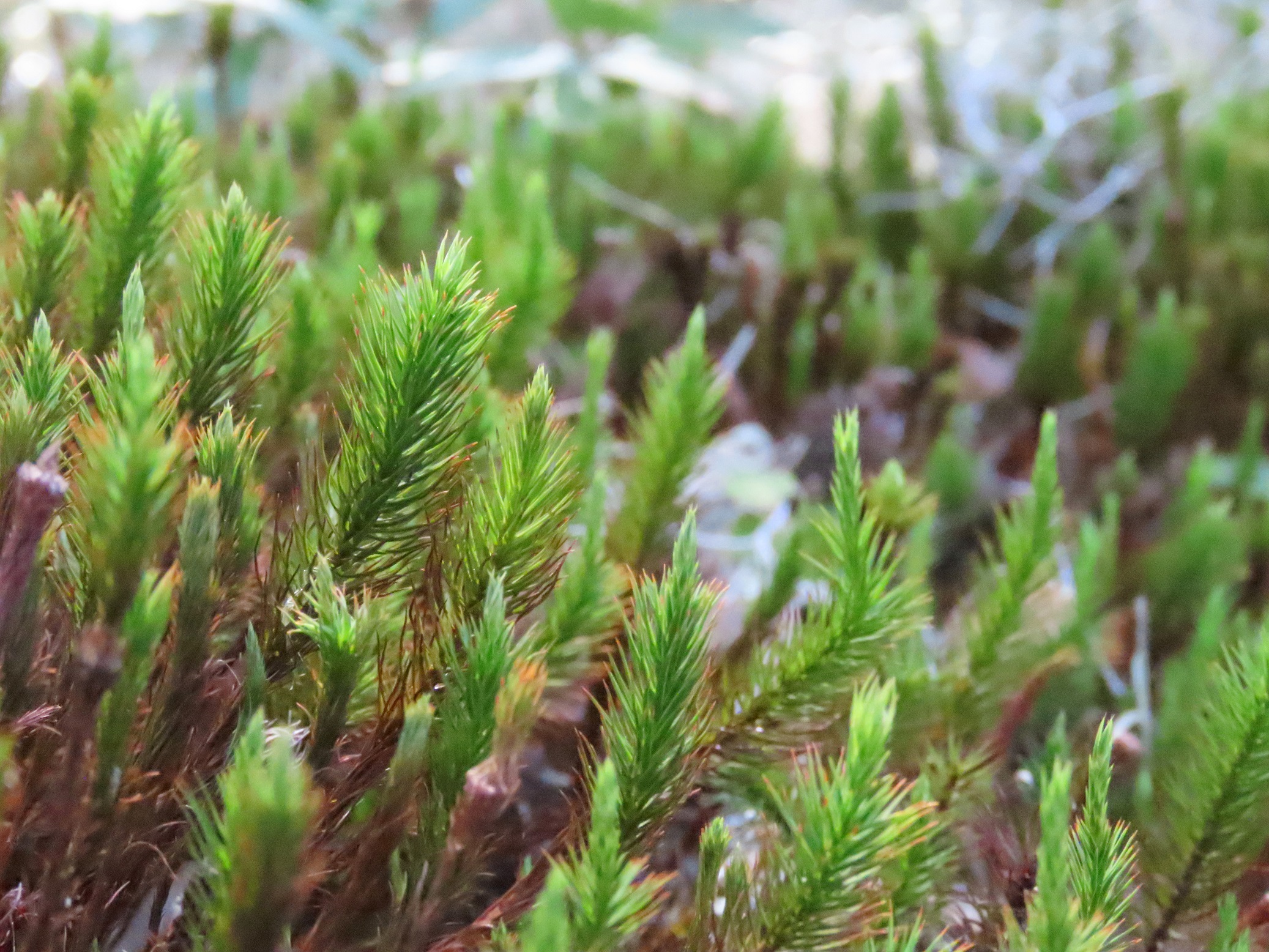
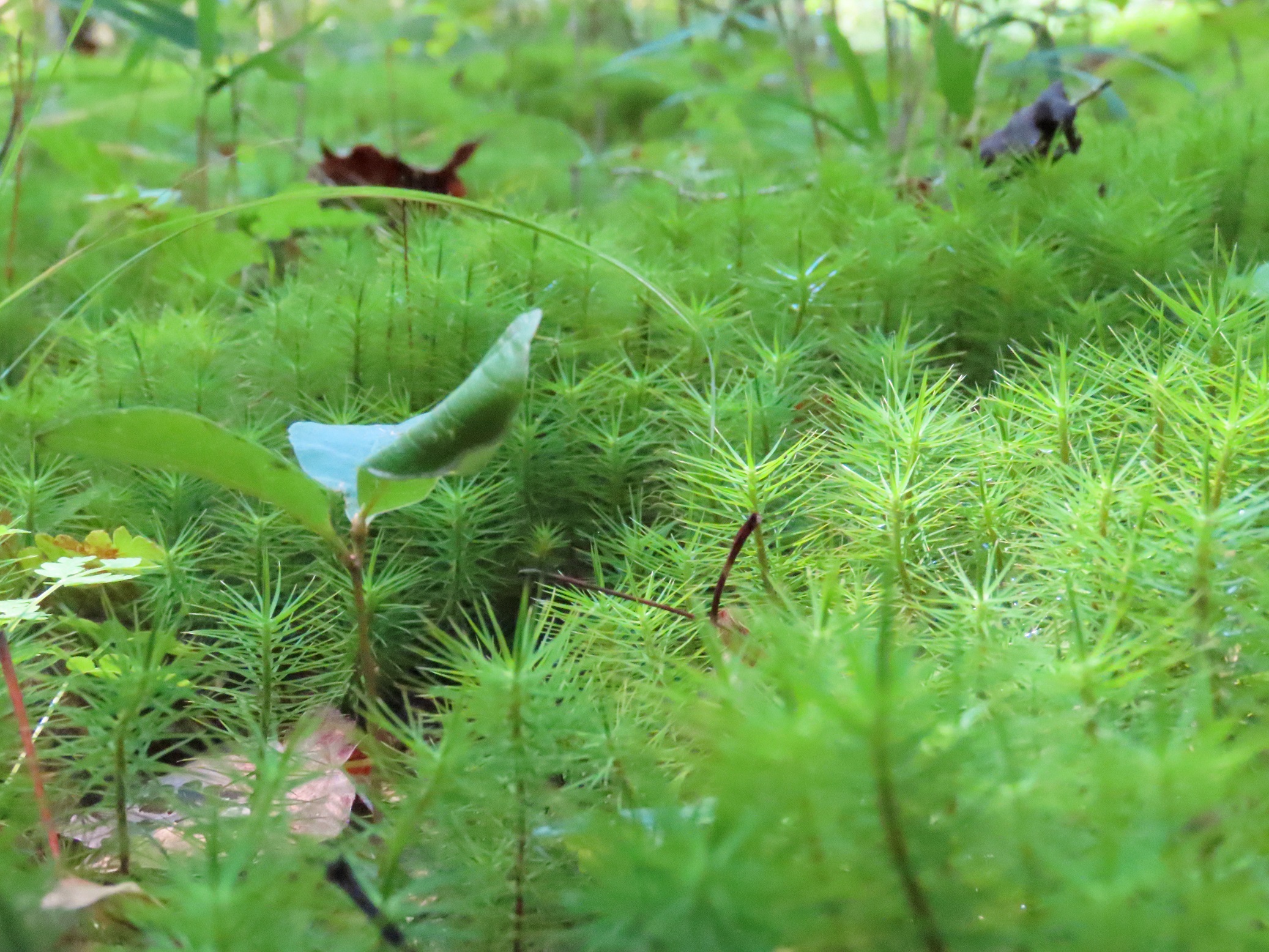
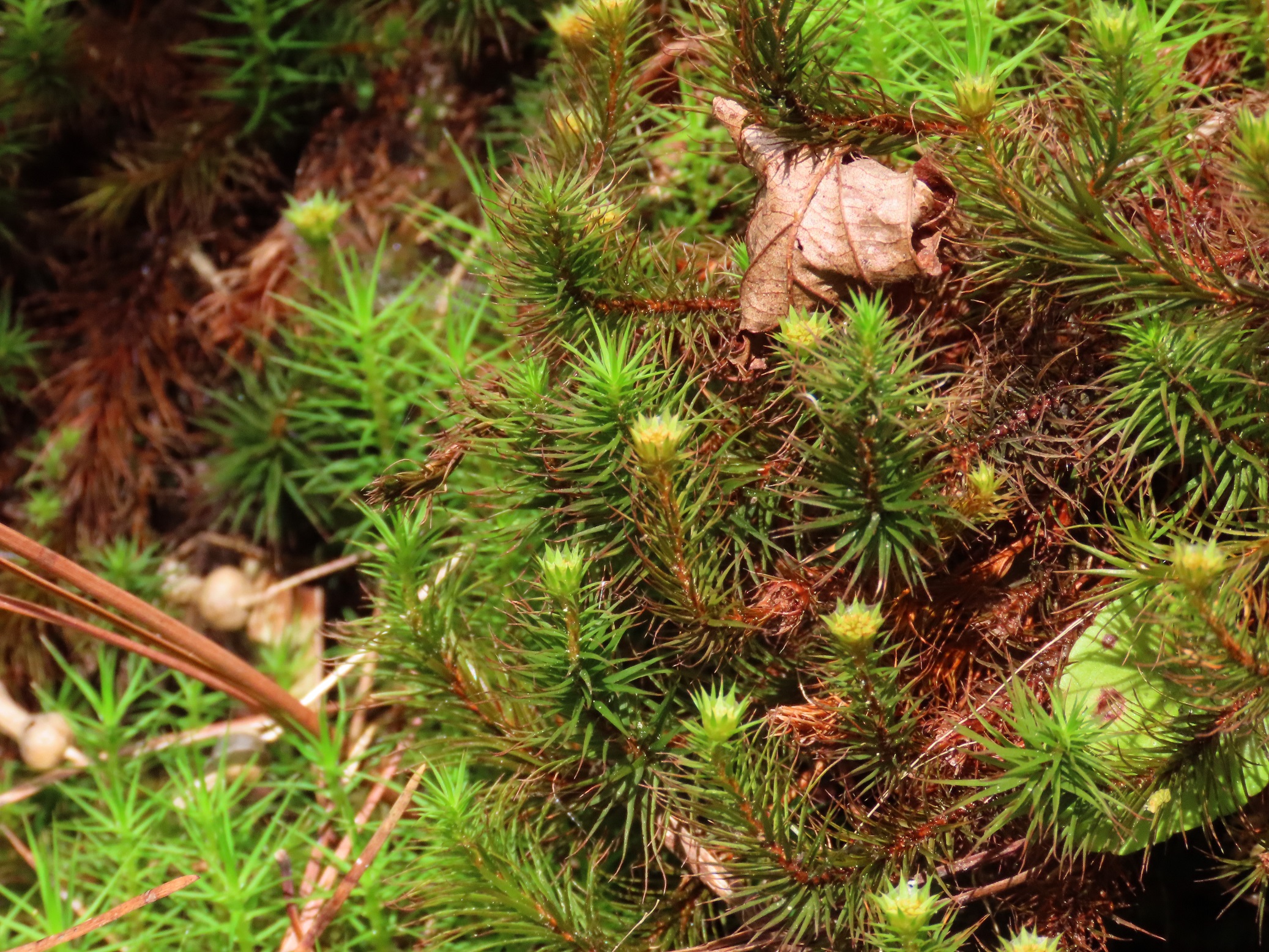
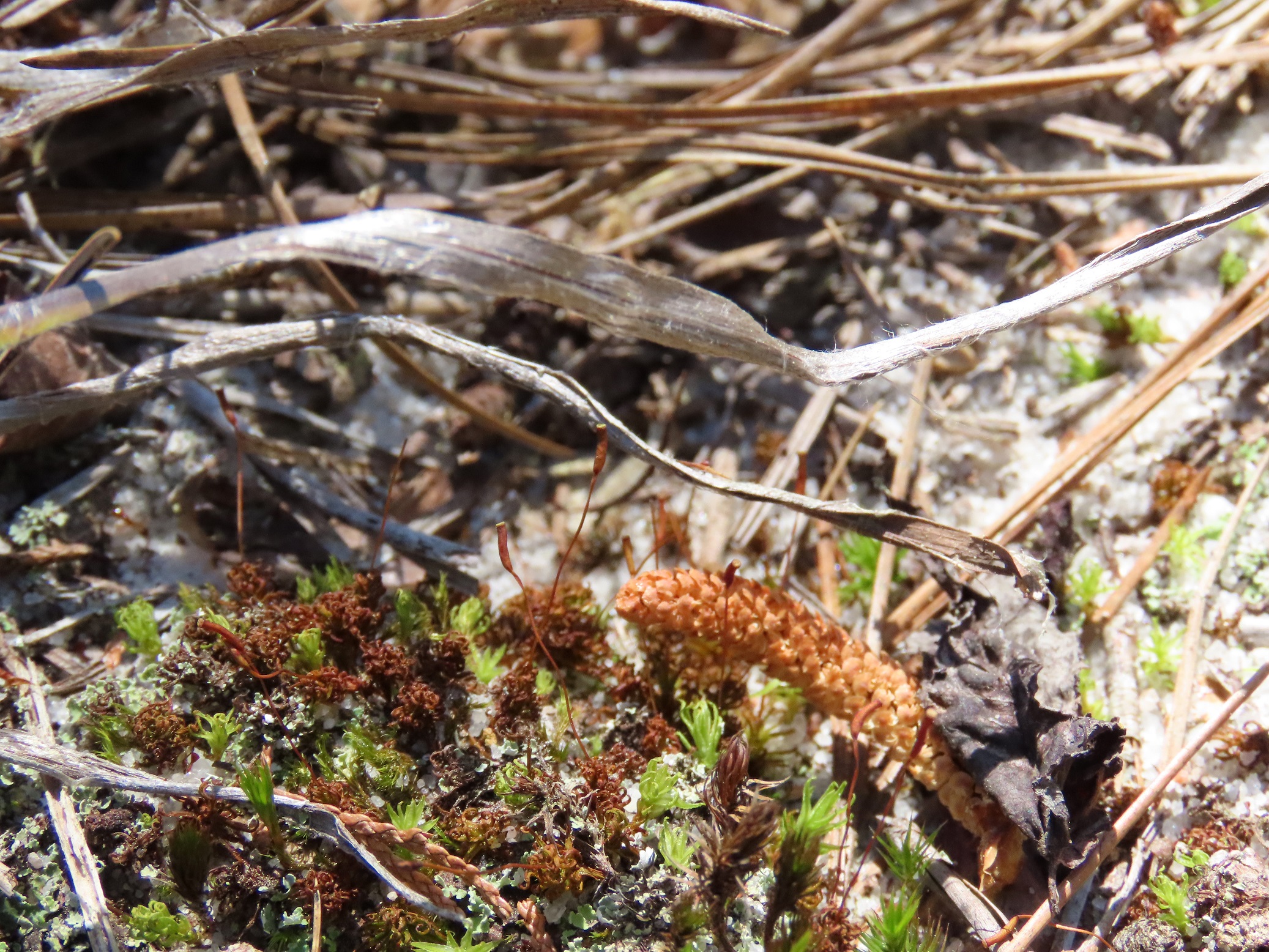

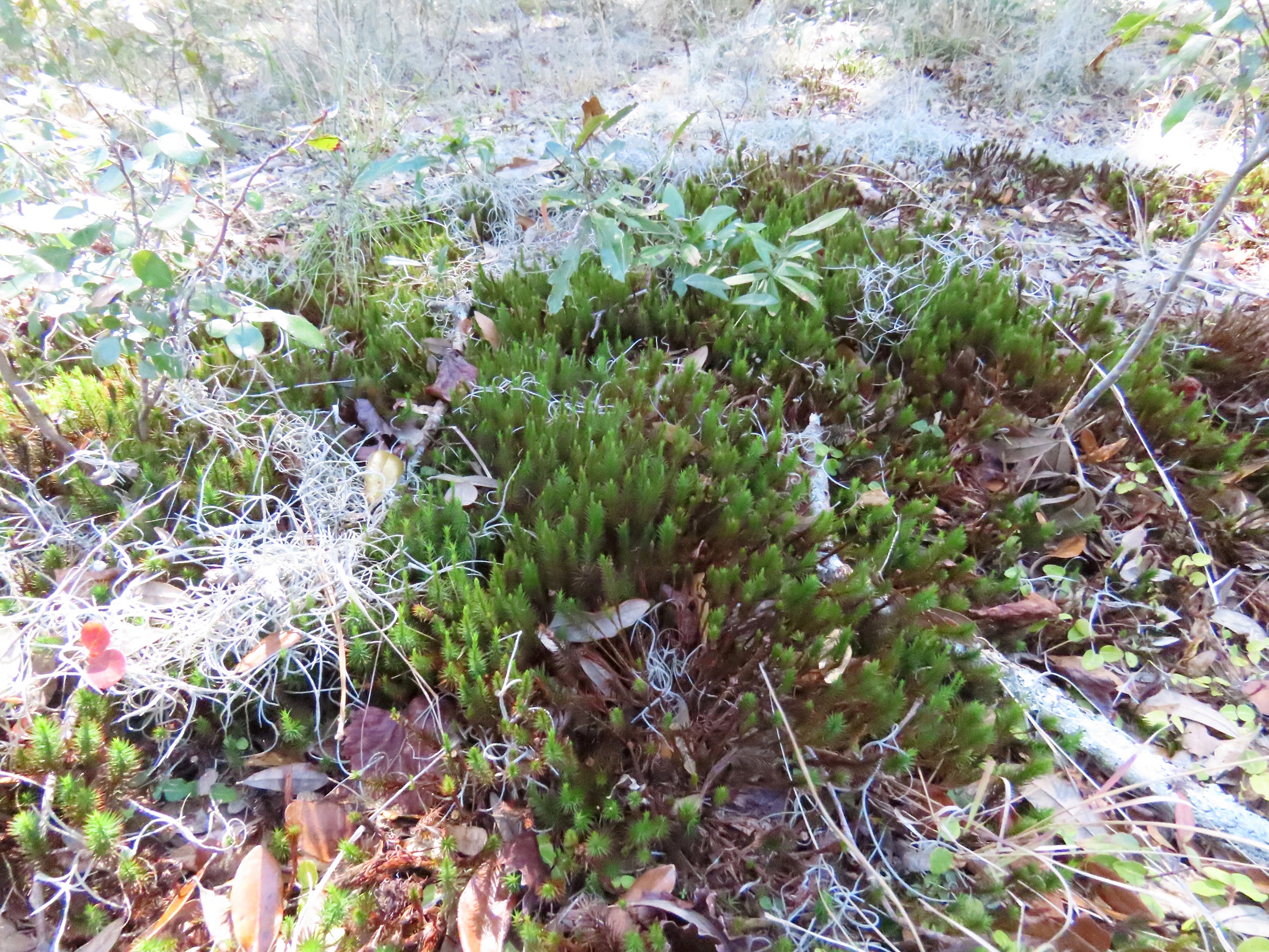
These two species look incredibly similar. One of the easier ways to tell them apart is through their leaves under droughty conditions. Common Haircap’s leaves have a distinct downward curve to them, which can exaggerate as they dry. Juniper Haircap, conveniently and conversely, has straight leaves that fold upward tightly against the stem as they dry. If you look really, really close at the leaf margins, Common Haircap is serrate all the way towards the tip. But you’ll likely need a hand lens to see this. Both species grow in mats on the soil’s surface, like a lush shag carpet. Each stem is usually one to three inches in height and ringed in narrow needle-like leaves, giving it the shape of a bottle brush.
In order to go any further, we’ll need to take a detour for a crash course on Moss biology. Mosses are plants, but very primitive plants. They lack the means to produce the polymer lignin. Lignin gives plant cell walls their rigidity. It’s what makes wood “woody”. Like steel reinforced concrete, lignin is the rigid cement and cellulose the flexible steel scaffold. It’s also critical to the proper structural formation of vasculature and roots in plants. Thus, lacking lignin, Mosses lack roots and the internal vasculature to transport water and nutrients around their body. Instead, they’re basically a sponge, passively wicking water from the soil’s surface and through their skin throughout the rest of their body. They must also sponge mineral nutrition from the environment, absorbing it not only from the soil but through windblown dust and ash they trap between their leaves, and from the acids and other trace nutrients dissolved in rainwater.
Now it gets weird and I have no choice but to start using the big science words. Mosses don’t reproduce with flowers nor with seeds. They pre-date both. Instead, they produce capsules and spores. But these are produced by a second plant, which grows on top of the first plant. (I told you it was getting weird.) The Haircap Moss we see, that we all know and love, is a gametophyte. It’s a haploid. It only has one set of chromosomes. It has half the genetic material of the organism, just like sperm and eggs in animals. In spore reproducing plants, including Mosses, Clubmoss, Horsetails, and Ferns, the gametophyte is the main life stage that anchors to the soil, photosynthesizes, and lives a long healthy life. The opposite is the case in flowering plants and gymnosperms (E.G. pines, cedars, cypresses).
The gametophyte of Haircap Moss, when mature, will produce a dense spiny disk at the tip of the stem. Haircap Moss is dioecious, meaning it has male and female plants. Male plants grow an Antheridium, female plants an Archegonium. When rainwater lands into the bowl-shaped male Antheridium, it splashes sperm away with it. If those droplets of water land on a nearby female Archegonium, it’ll be fertilized. From within this Archegonium cradle, a diploid sporophyte, with a full set of chromosomes, will grow directly out of the tip of the gametophyte’s stem. In Haircap Moss, this sporophyte derives all its water and nutrition by leeching from its parent gametophyte. When the sporophytes of Haircap Moss begin to emerge, they’re spear-shaped and protected by a fibrous sheath that whitens and frays away with age. The orange-brown sporophytes of Haircap Moss are shaped like a golf club when mature, with a skinny stalk holding aloft a rounded oblong lump of a capsule at a roughly right angle. This capsule will produce gamete spores and, once the sporophyte dies, the capsule dries and will pop open, scattering spores into the wind.
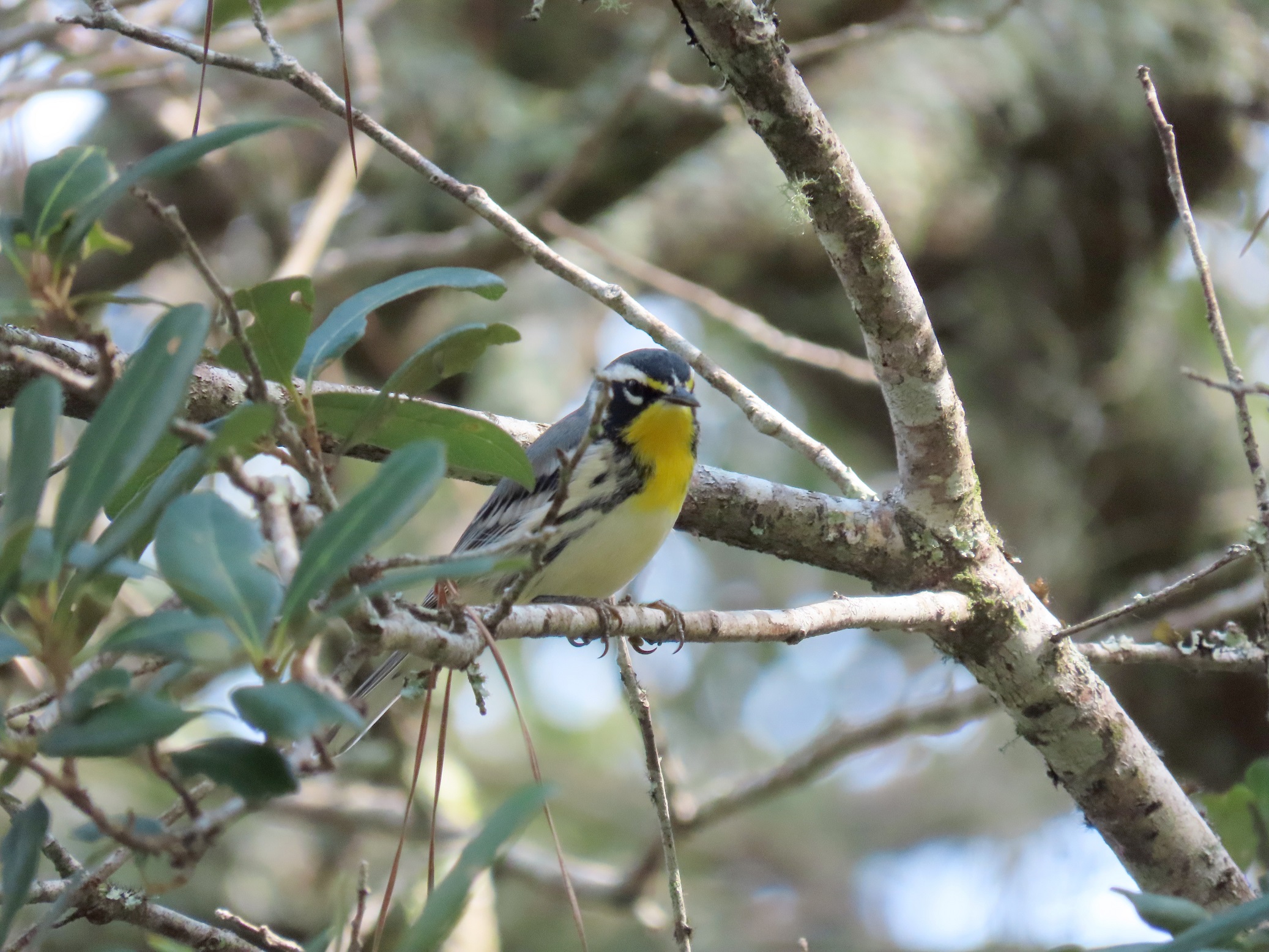
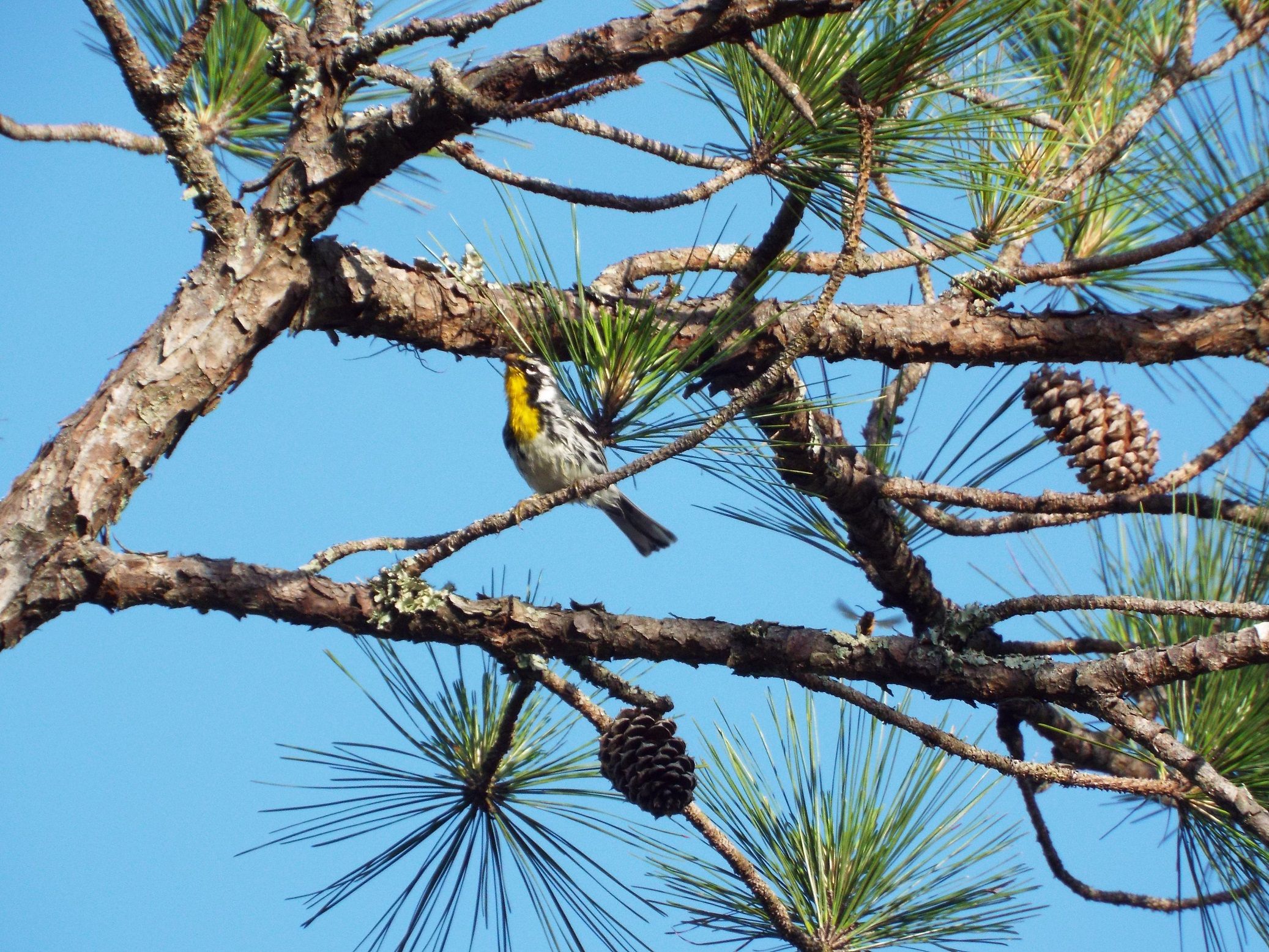
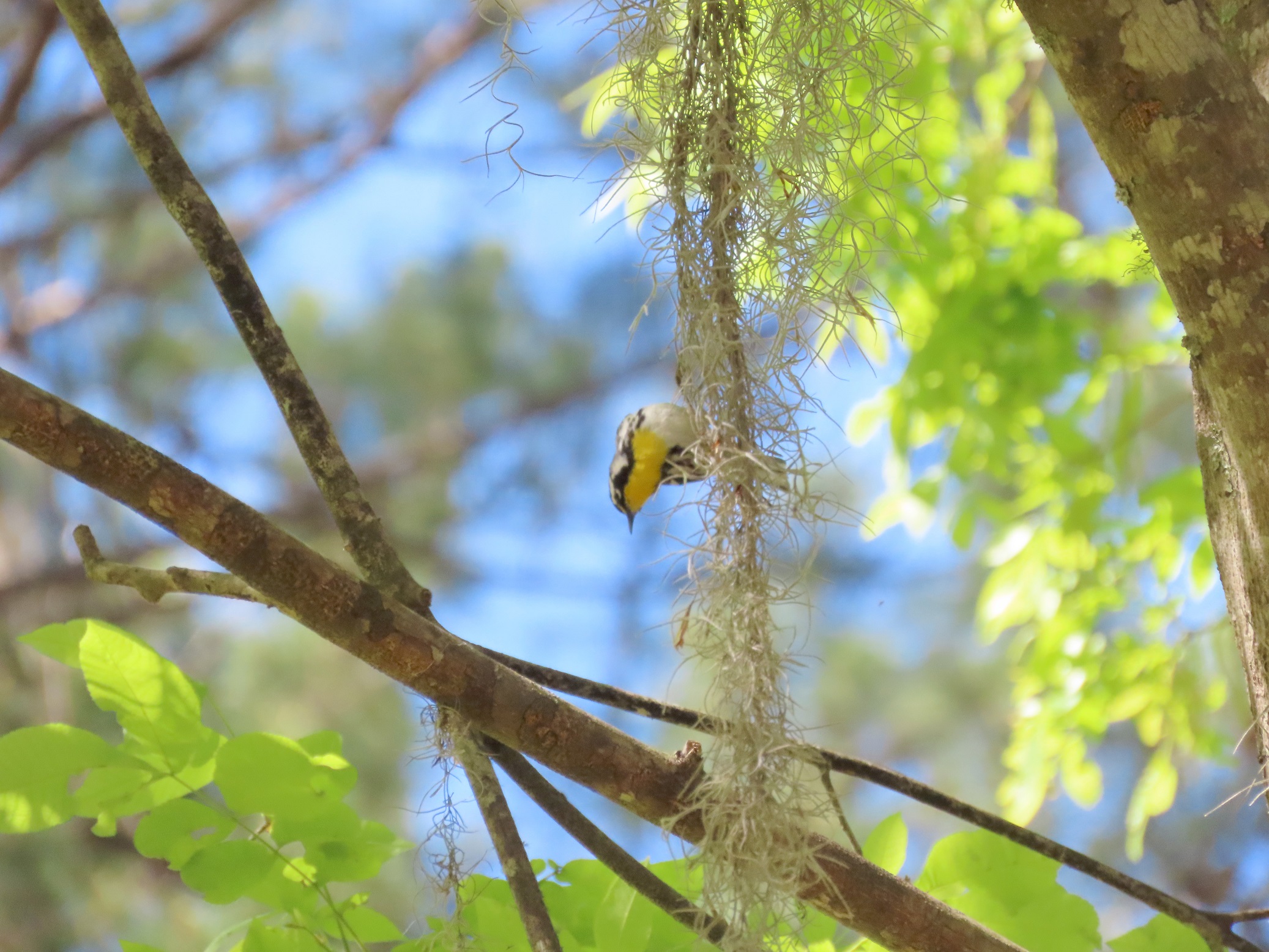
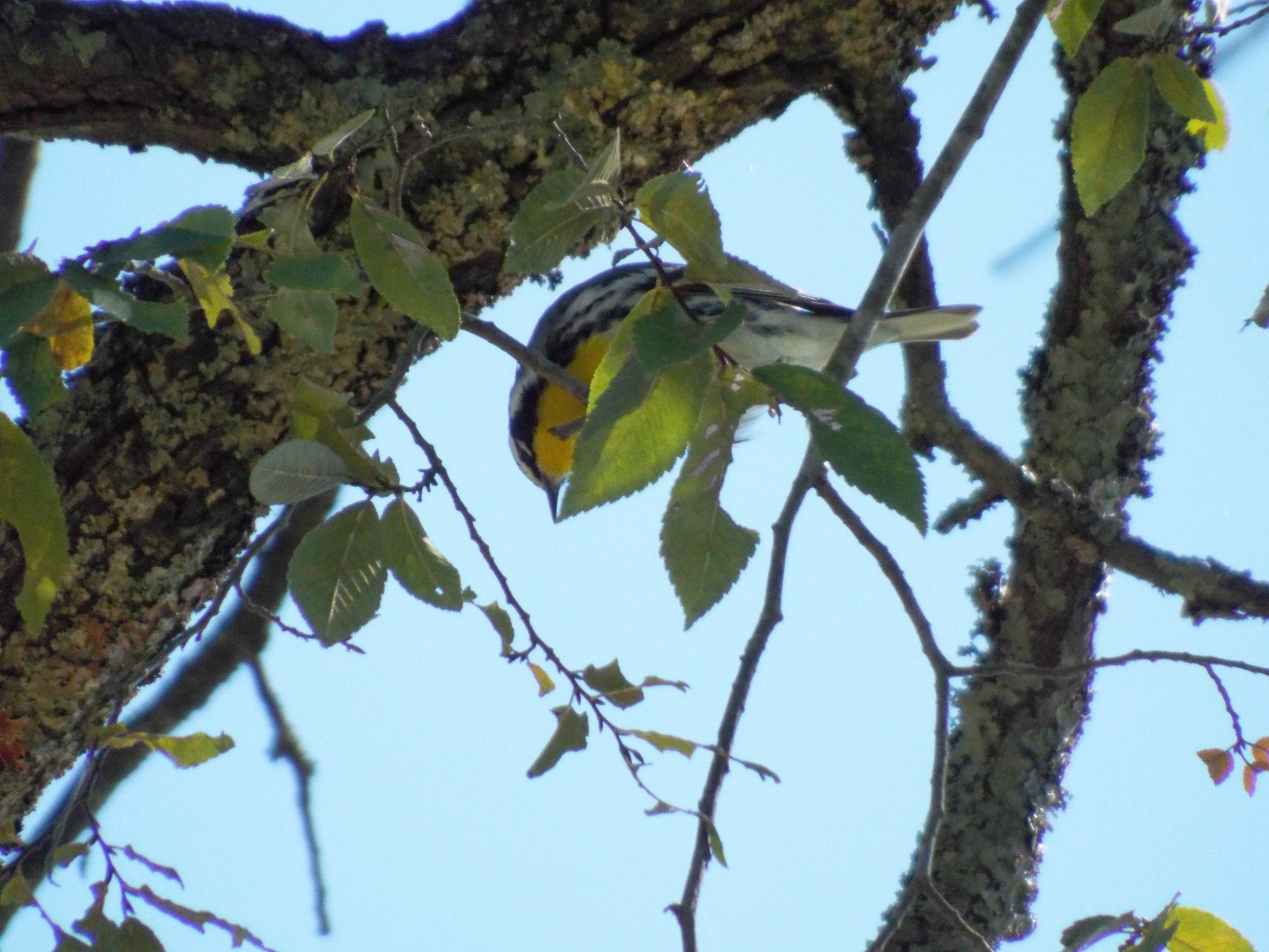
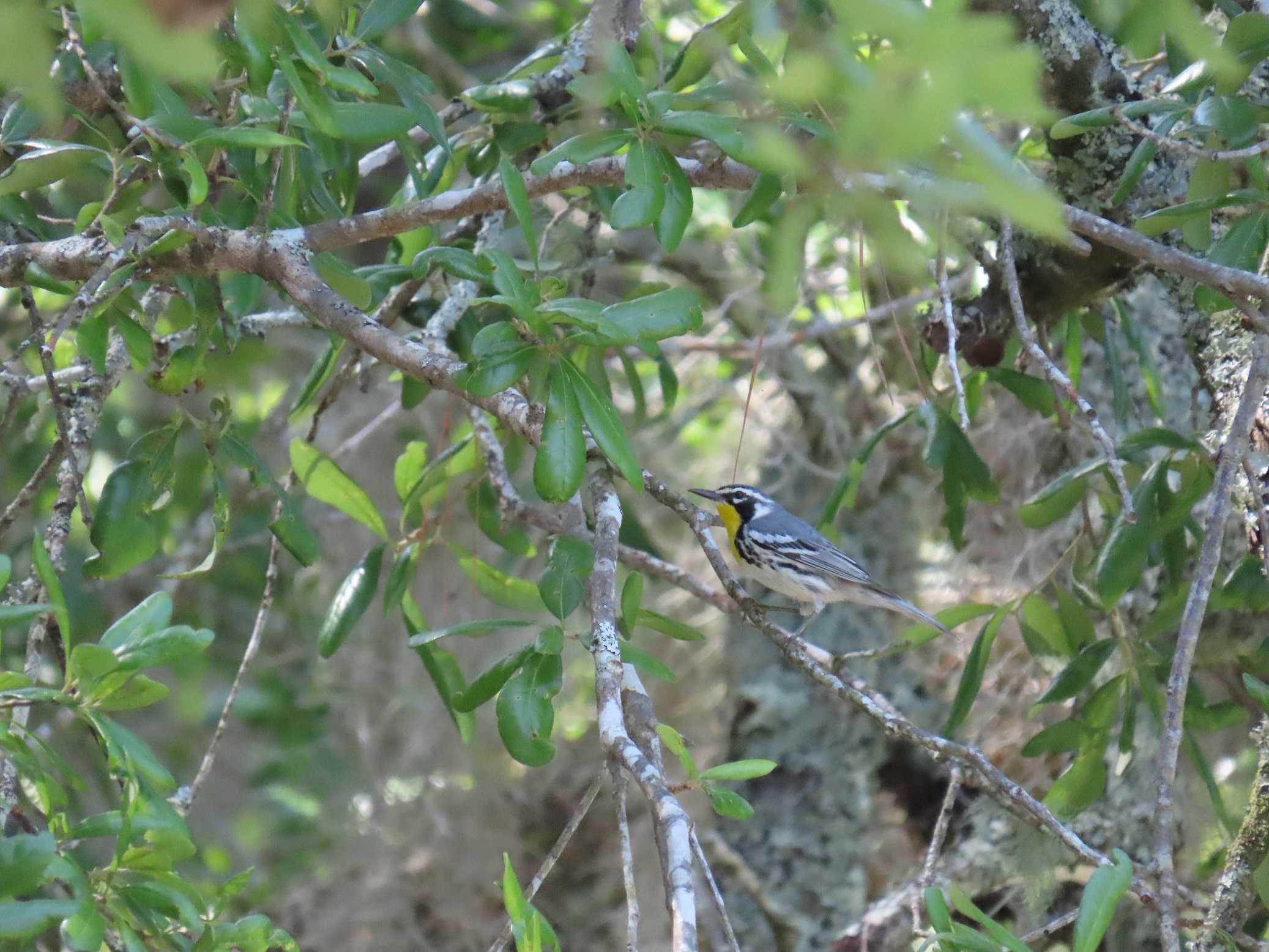
This week for Flora and Fauna Friday, it’s our sulfur throated spring songster, the Yellow-throated Warbler (Setophaga dominica).
On the threshold of spring, a monochrome spec smears itself across the horizon, melting upon a canvas of pale-gray moss. Then, like day’s break into the chilled sky of morning, a flash of yellow illuminates the gray. A golden glow shines from that spec, while a chorus of birdsong follows from it in kind. Our Yellow-throated Warblers are staking their spring claims.
The Yellow-throated Warbler’s summer range extends across much of South Carolina. They are most abundant on our coast and even live year-round here on the Sea Islands. They are abundant in maritime forests, the fringes of cypress swamps, and the wetland margins and valleys of pineywoods. But, pretty much anywhere on the coast with plentiful hardwood tree cover is suitable habitat for them.
Male and female Yellow-throated Warblers look much the same and are mostly monochrome birds: Black legs, black beak, black eye, black mask, gray back, white belly, and black wings broken by two heavy, white wing-bars. Their face is distinct with a strong white stripe above the eye, a white bag below the eye, and a white crescent behind the cheek that frames a black cheek patch, which blends above into a black eye-stripe and flows below like drops of black ink down its flank. This face serves as a frame for their namesake yellow throat, an explosion of rich sunflower-yellow glowing from chin to chest, sometimes radiating up to the lores in front of their eyes. From this iconic mug emerges a rather long and stout bill for a warbler, with an ever so subtle hook to the tip.
Yellow-throated Warblers are one of the earliest warblers to begin migrating north. They begin singing on Edisto Island near the end of February. Males sing a pleasant, rhythmic song of a dozen notes that fall in pitch while speeding up, before rising back with the last note or two. Pairs build their nest most often here in Spanish Moss, weaving the crook of a tangled beard into a hammock before lining it with straw and webs. I occasionally see them eviscerating the webs of spiders and tentworms for their silk, leaving the terrified web’s keeper thoroughly confused and homeless. Yellow-throated Warblers provision themselves and their young with a diet of insects and arthropods, patrolling tree branches throughout the year for tasty morsels.
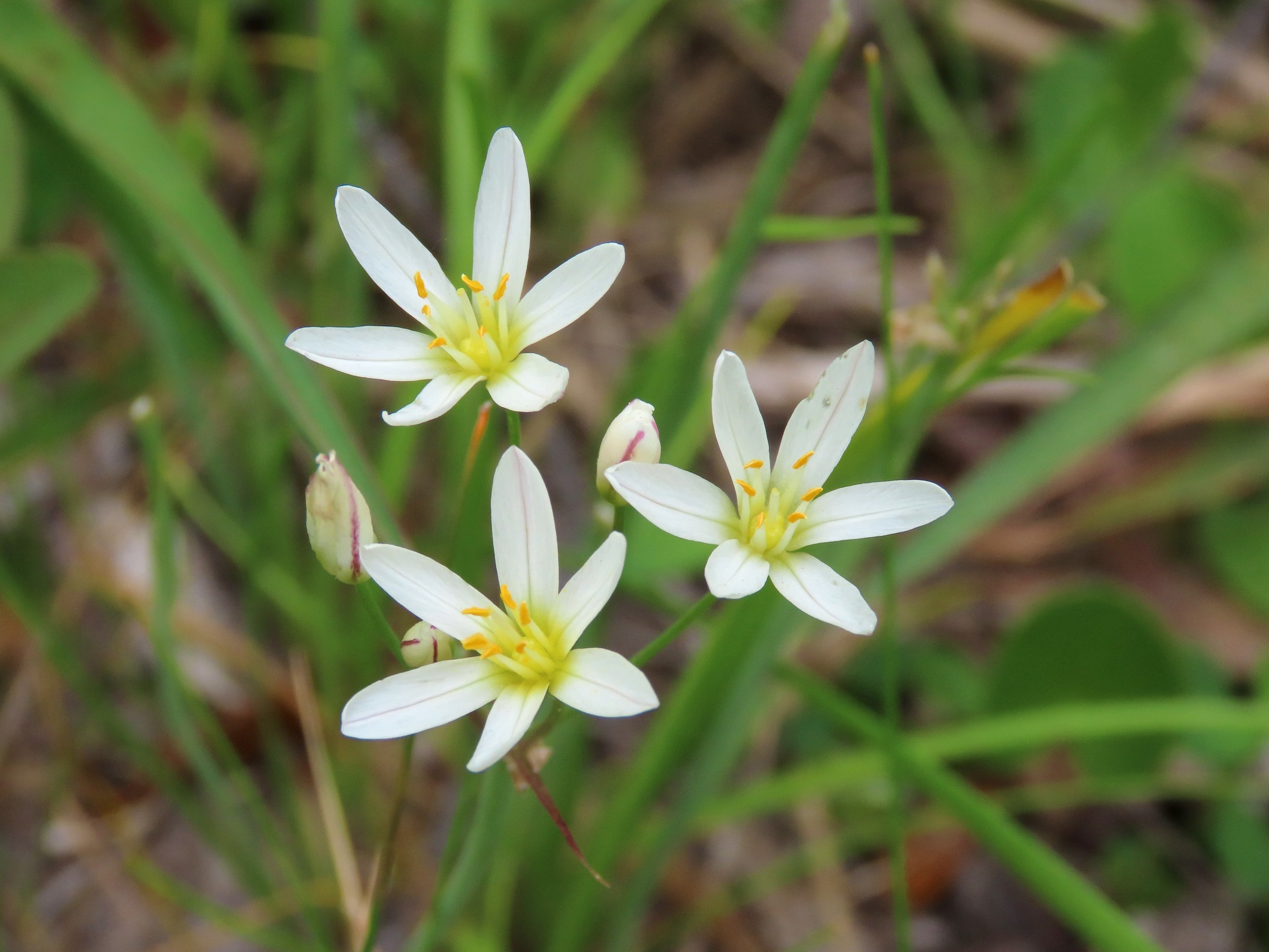

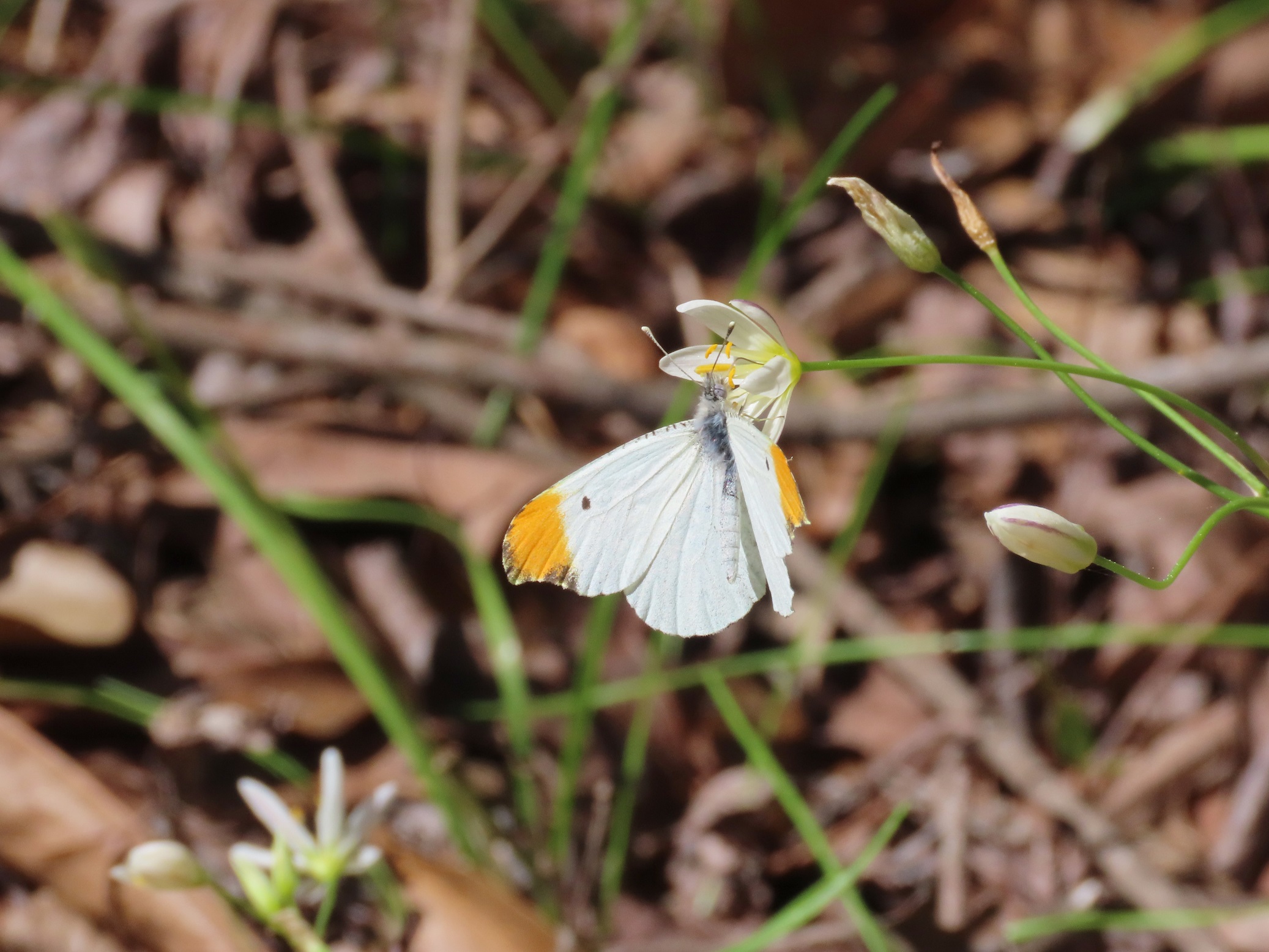

This week for Flora and Fauna Friday it’s one of our widespread winter wildflowers, Crowpoison (Nothoscordum bivalve).
Crowpoison, also called False-Garlic, is a common wildflower found throughout the Southern United States, including all of South Carolina. It’s a member of the Onion subfamily, Allioideae, and a cousin of Onion and Garlic (genus Allium). Crowpoison is a hardy perennial found in a wide array of locales. It’s most abundant in fertile glades in river floodplains, in sandy barrens, and along road shoulders. Those three habitats share little in common! But the common thread they do share is sparse or short understory vegetation and full sun. Crowpoison has but a few narrow, grass-like leaves emerging from a small bulb, much like true garlic, but with a much smaller bulb. In order to eke out a living with that scant foliage, it needs lots of sunlight. So as long as it can soak up enough sun, it can grow in some of the worst soils and most disturbed sites nature has to offer.
Crowpoison blooms on the Sea Islands starting in late February but peaks statewide throughout March. Its flowers are about a half-inch wide with six petals, cotton-white with a faint green stripe down their middle, and a lemon-yellow center ringed with six short golden anthers. Very similar in shape to an individual Onion or Garlic flower. These flowers bloom most often three to six at a time, held aloft the soil on a narrow flower stalk no more than a foot high. These flowers are a great little nectar plant for early spring wildflowers. They are relied upon heavily by the Falcate Orangetip (Anthocharis midea); a scarce species of butterfly that flies whilst Crowpoison blooms and prefers similar habitats. The flowers, once pollinated, mature over spring to yield six hard, black, triangular seeds.
Let’s talk about names for this plant real quick. The scientific name “Nothoscordum bivalve” means “two-halved false-garlic” referencing its two papery bracts, which protect and sheath new flower buds, and that this plant looks a lot like wild garlic, but isn’t. If you’re ever stumped wondering if you’ve got a False-Garlic or a real Garlic, our False-Garlic lacks the trademark Onion smell. The “Crowpoison” common name is a bit of a mystery. No one knows if it is actually poisonous to crows or not. It’s not even really certain if it is toxic to humans or not. I’ve read some vague and apocryphal tales that the name originates from a Native American legend, where the plant was used to brew a poison to keep the crows from murdering the corn crop, but the current consensus is, no one knows!
Crowpoison, being a bulb plant, is a perennial that returns each year. It can also reproduce through “pups”, tiny bulblets that emerge from the base of the main bulb. Pups are a clone of the parent plant and will grow into their own bulb with time. These do two things: they form a small colony around the parent plant and they serve as an insurance policy. If the parent plant dies from herbivory, pests, uprooting, or just plain old age, then its offshoots will take its place. Crowpoison is not a prolific pup producer though. So, it’s most often found singly or in sparse clumps.
However, there is another False-Garlic species on the landscape, Slender False-Garlic (Nothoscordum gracile), which pumps out pups like crazy and rapidly forms dense colonies. This skill has elevated Slender False-Garlic into an invasive species in certain areas of the United States, particularly Southern California, the Mississippi and Mobile Delta on the Gulf Coast, and certain regions around Charleston. Slender False-Garlic is native to South America but was brought to the United States as an ornamental. You can tell it apart from our native Crowpoison from its much wider and longer bluish-green leaves, taller flower stalks, April bloom time, and propensity for forming colonies.
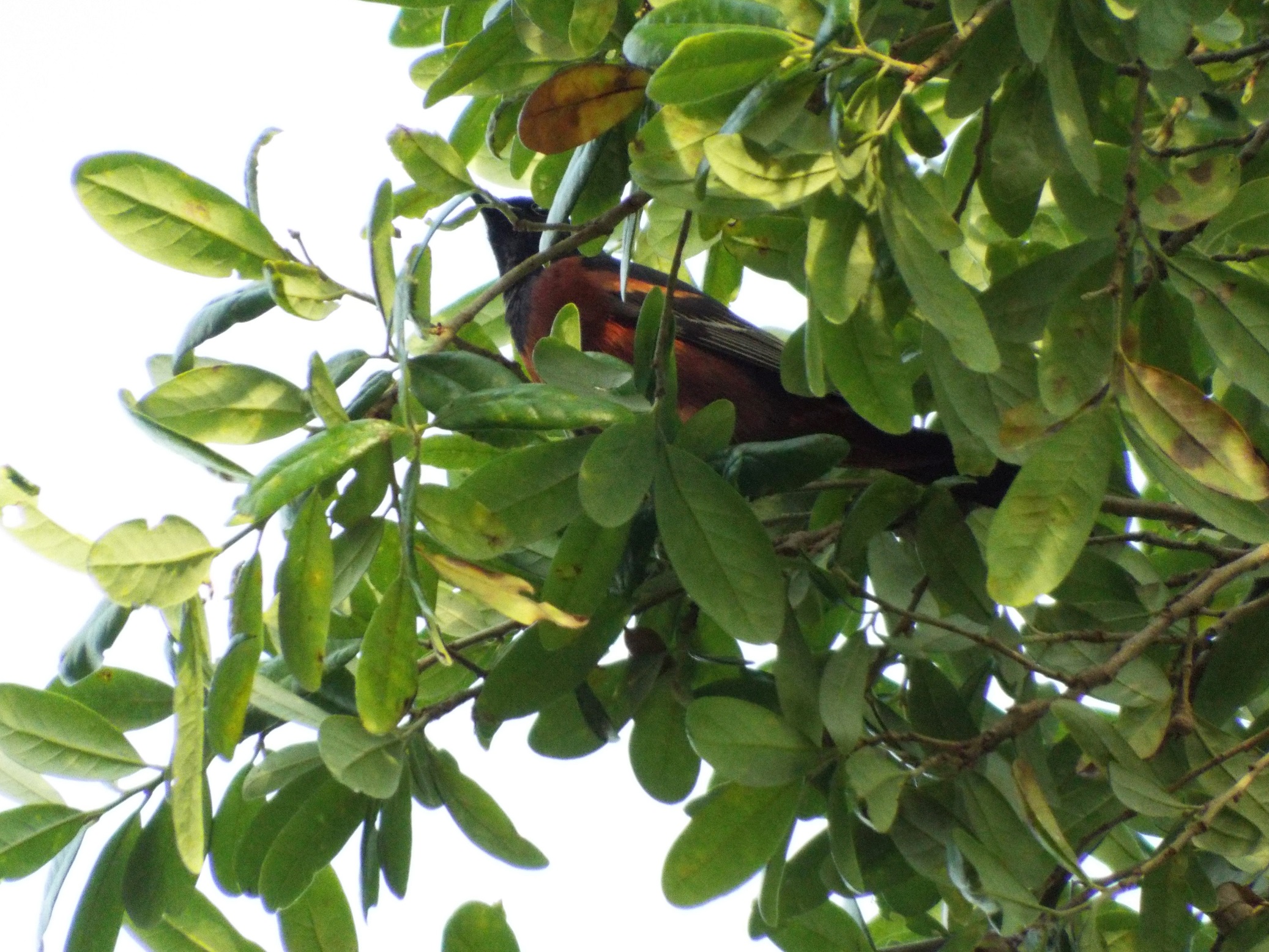
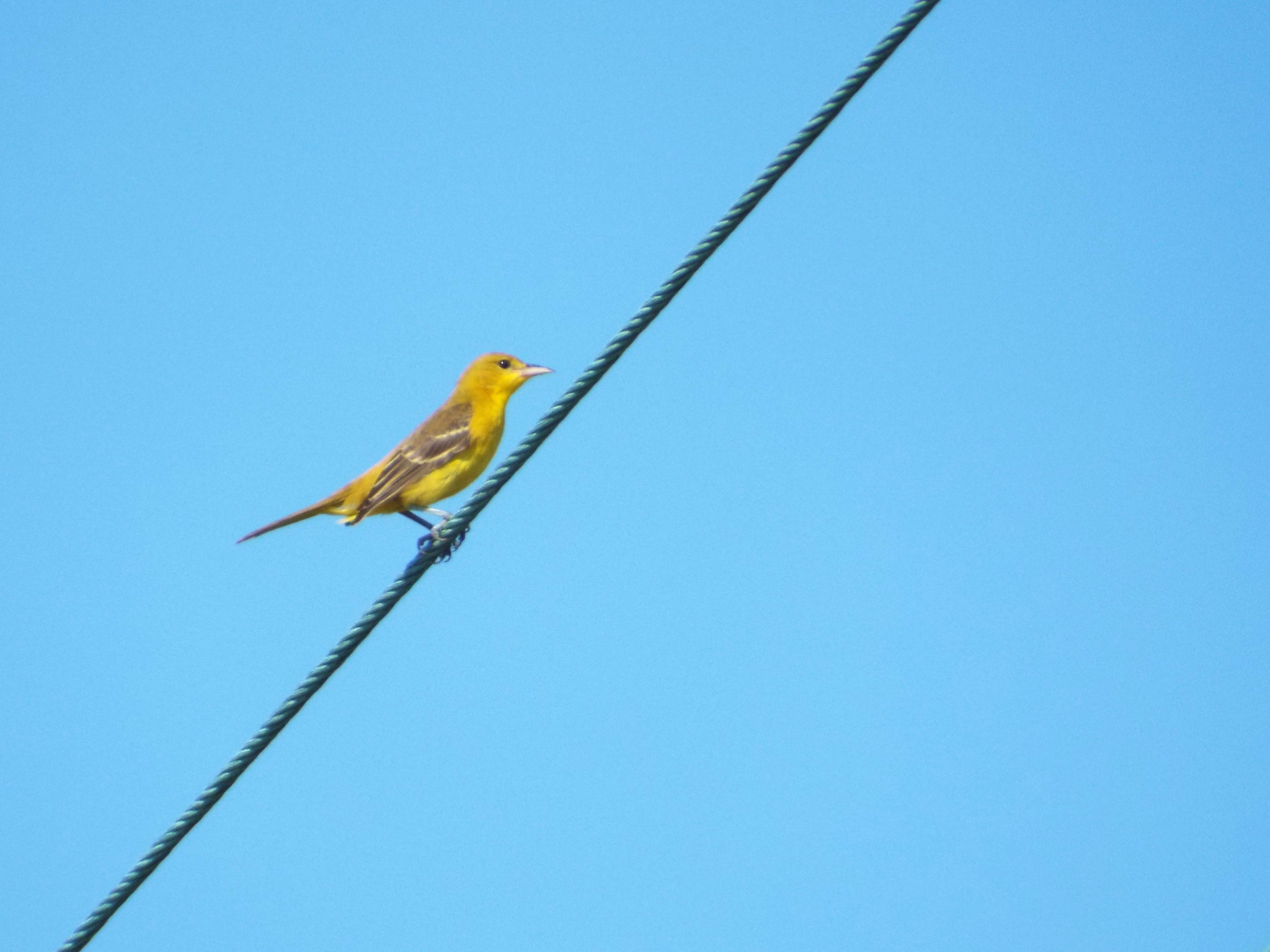
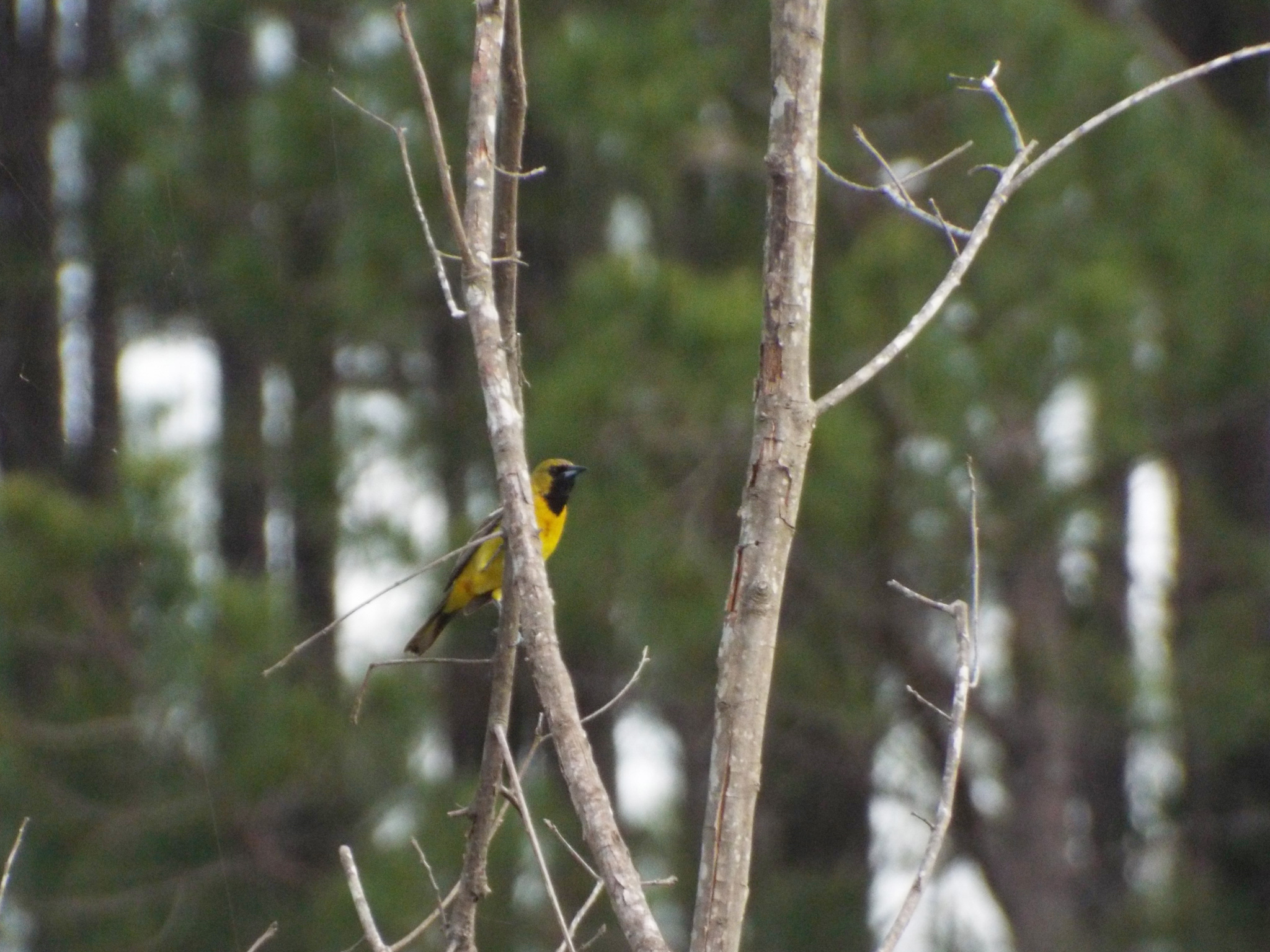

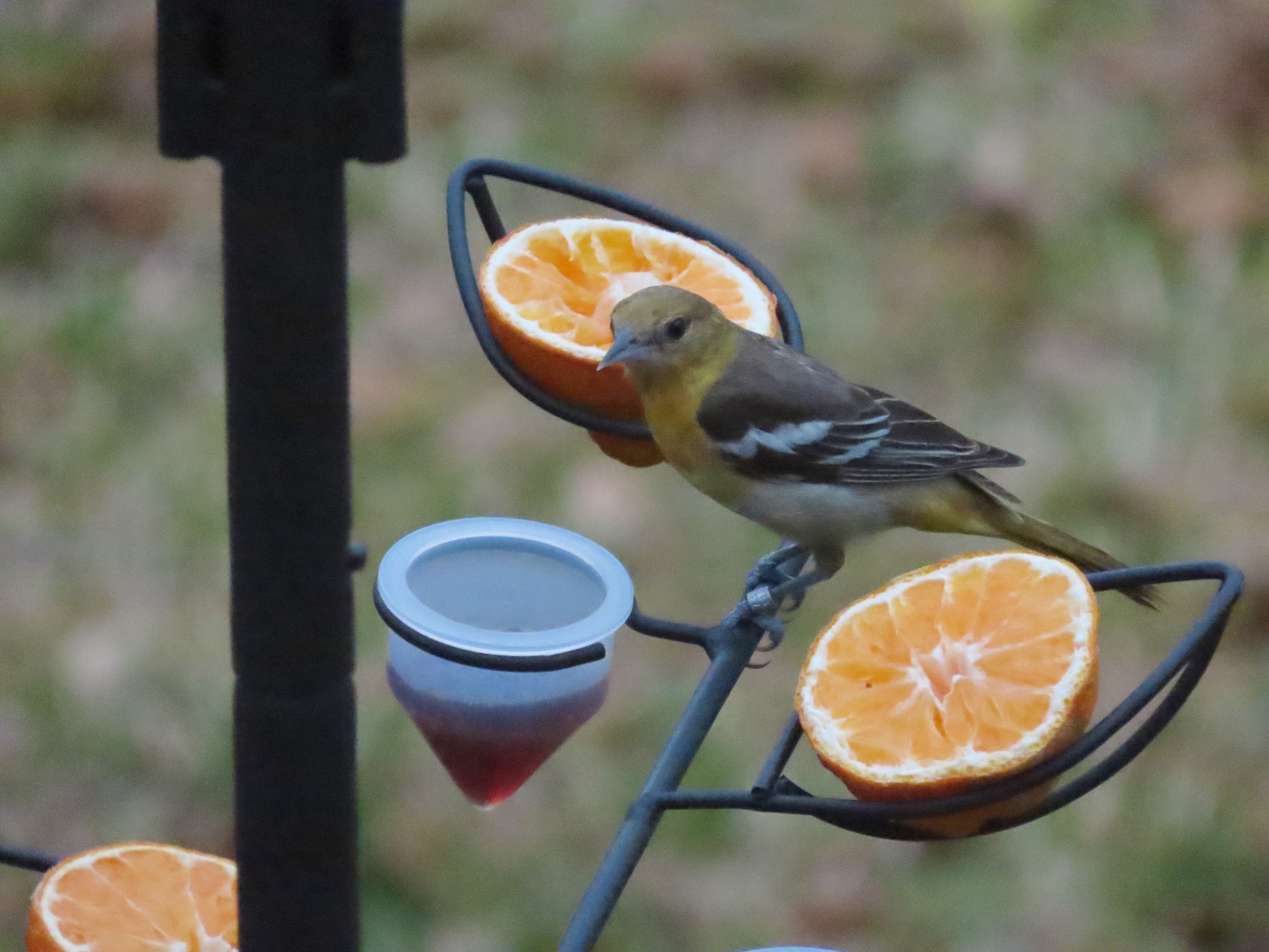

This week for Flora and Fauna Friday we’re keeping an eye out for a radiant pair of fruit-loving birds, the Orioles, genus Icterus.
Here in South Carolina, we have two species of Oriole, the Orchard Oriole (Icterus spurius) and the Baltimore Oriole (Icterus galbula). Orioles belong to the Blackbird family Icteridae, alongside Grackles, Meadowlarks, Cowbirds, Bobolinks, and, of course, Blackbirds. Orioles share many of this family’s more common features including a sharp bill and deep black feathers accented by a shade of red, orange, or yellow. The root of the family name Icteridae means “jaundiced” in reference to the prevalence of yellow and orange plumage in many Blackbird species. Both of our Oriole species can be found across much of the Eastern United States and throughout all of South Carolina. Yet their presences here in the Lowcountry alternate with the seasons. Orchard Orioles suffer alongside us during our sweltering summers and Baltimore Orioles linger here for our mild winters.
The Orchard Oriole is small for an Icterid, with an overall size similar to a Brown-headed Cowbird but erring smaller with a slim, streamlined build. Their bill is sharp with a slight decurve. The male’s plumage is jet-black contrasted by a rich cinnamon-brown on the back, breast, and belly. Females are chartreuse-yellow across the body with black-gray wings. Immature males look much the same as females but with a black beard. Orchard Orioles nest in South Carolina and can be found here from spring into fall. Their song is a complex warble of disjointed notes that, to the ear, seems to follow no rhyme nor reason, changing pitch and character every note. They prefer habitats with a mix of open land and hardwood trees. Field edges, neighborhoods, savanna margins, and their namesake orchards are common haunts for Orchard Orioles. Yet they aren’t particularly abundant on our landscape and this Oriole can be a difficult bird to pin down in the Lowcountry.
The Baltimore Oriole is a larger bird, growing to a size somewhere between Cowbird and Red-winged Blackbird. Their bill is longish, sharp, and with a narrow triangular shape. The male possesses a jet-black head and mantle extending down to black wings streaked with white. His belly and breast are dyed a rich saffron-yellow bordering on orange. Females have a similar plumage but are muted somewhat in color and with a golden-khaki head instead of black. Their song is a strikingly musical verse of whistled notes, distinct and flute-like, cutting through the other birds’ chatter to the forefront of the soundscape; the same way an unanticipated Jethro Tull flute solo on the local classic rock station breaks its way into your absentminded consciousness. Baltimore Orioles are only in South Carolina for the fall and winter, arriving with fall migration and departing in spring to nest up north. Their favorite habitats are river margins, open hardwood forests, forest edges, and suburbs.
Orioles subsist off of a diet of mainly insects, especially in the warming months. They’ll also sip nectar from large flowers, eat small berries, and pick at larger fruits. The Orchard Oriole, only being here for the warmer months, doesn’t eat a whole lot of fruit in the Southeast. The Baltimore Oriole on the other hand has quite the sweet tooth. They regularly winter around residences, suburbs, and urban forests whose scattered trees and brushy wooded margins mimic their natural habitats and provide an abundance of small fruits throughout winter. Here on the Sea Islands, there’s often an overladen citrus tree in every neighborhood for them to visit as well. They’ll even sneak sips from Hummingbird feeders! If you’d like to lay eyes on a Baltimore Oriole, they can be attracted to yards with cut fresh fruit skewered on branches and with fruit jelly feeders.
The South Carolina Department of Natural Resources would also like to see those Baltimore Orioles! Every February SCDNR conducts the Baltimore Oriole Winter Survey on the same weekend as the Great Backyard Bird Count (GBBC). For 2025 that weekend is February 14th through 17th. Most of the Baltimore Oriole population migrates to the tropics for winter but, over the last few decades, a group of Orioles started calling the Charleston area home. Ornithologists noticed this shift and started looking into it. In 2015, SCDNR started a public survey for Orioles in winter and the results were surprising. The Baltimore Oriole presence in the Lowcountry has been growing ever since. Currently, South Carolina boasts the largest population of overwintering Baltimore Orioles in the United States!
To help SCDNR with their survey, simply count the highest number of Baltimore Orioles you can see at one time, each day of the count, and report those numbers online, either through the SCDNR website or through eBird. (You can get more technical with data collection too if you want.) If you submit your Oriole observations through eBird, you’ll be able to report other bird species and simultaneously participate in the GBBC.
So go look at your window and count some birds!
Learn more about SCDNR’s Baltimore Oriole Winter Survey:
https://survey123.arcgis.com/share/67f948fa5f3e4243bdb72073346013f2
You can learn more about how to participate in the Great Backyard Bird Count at: https://www.birdcount.org/
-Tom A.
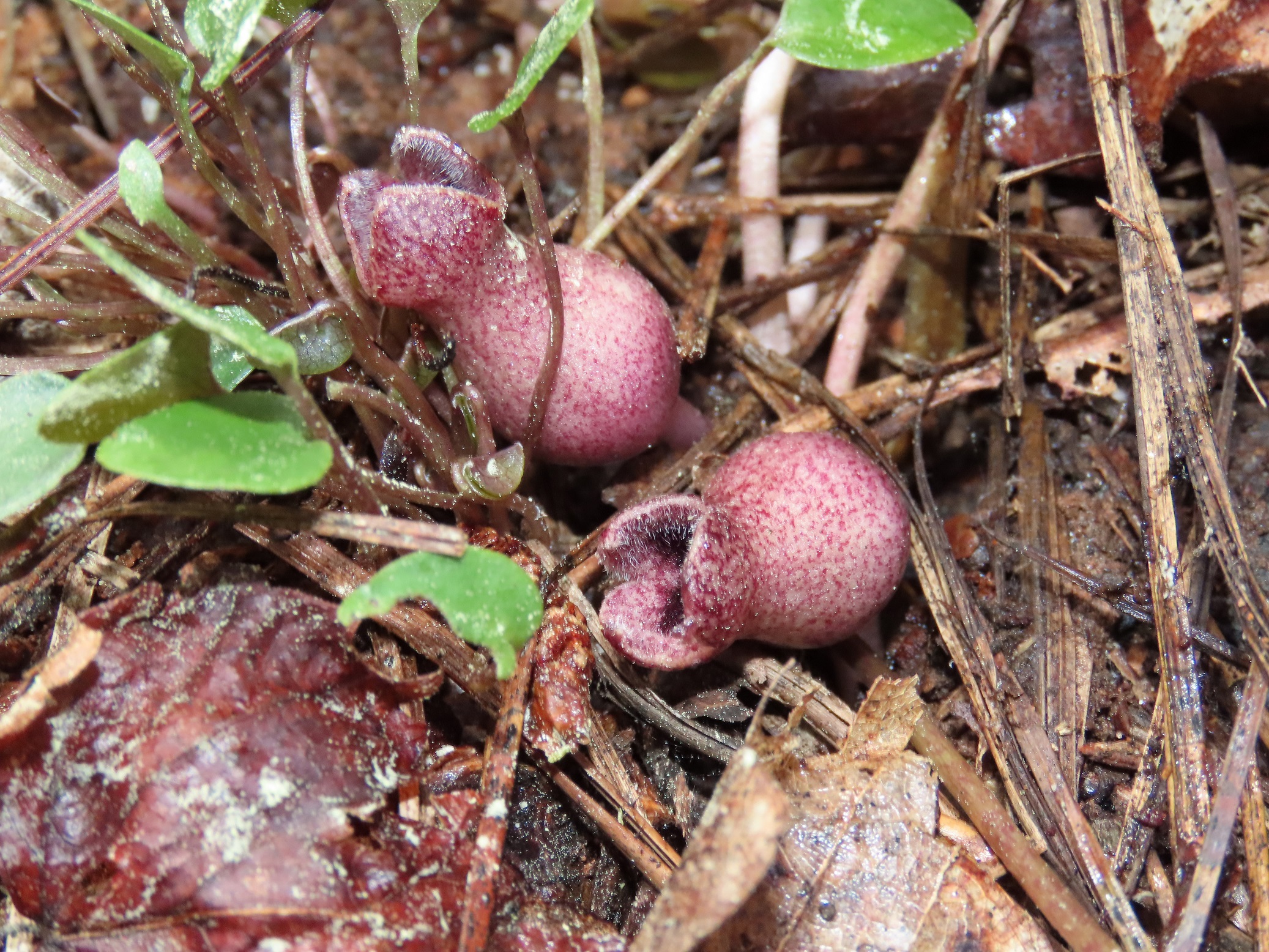
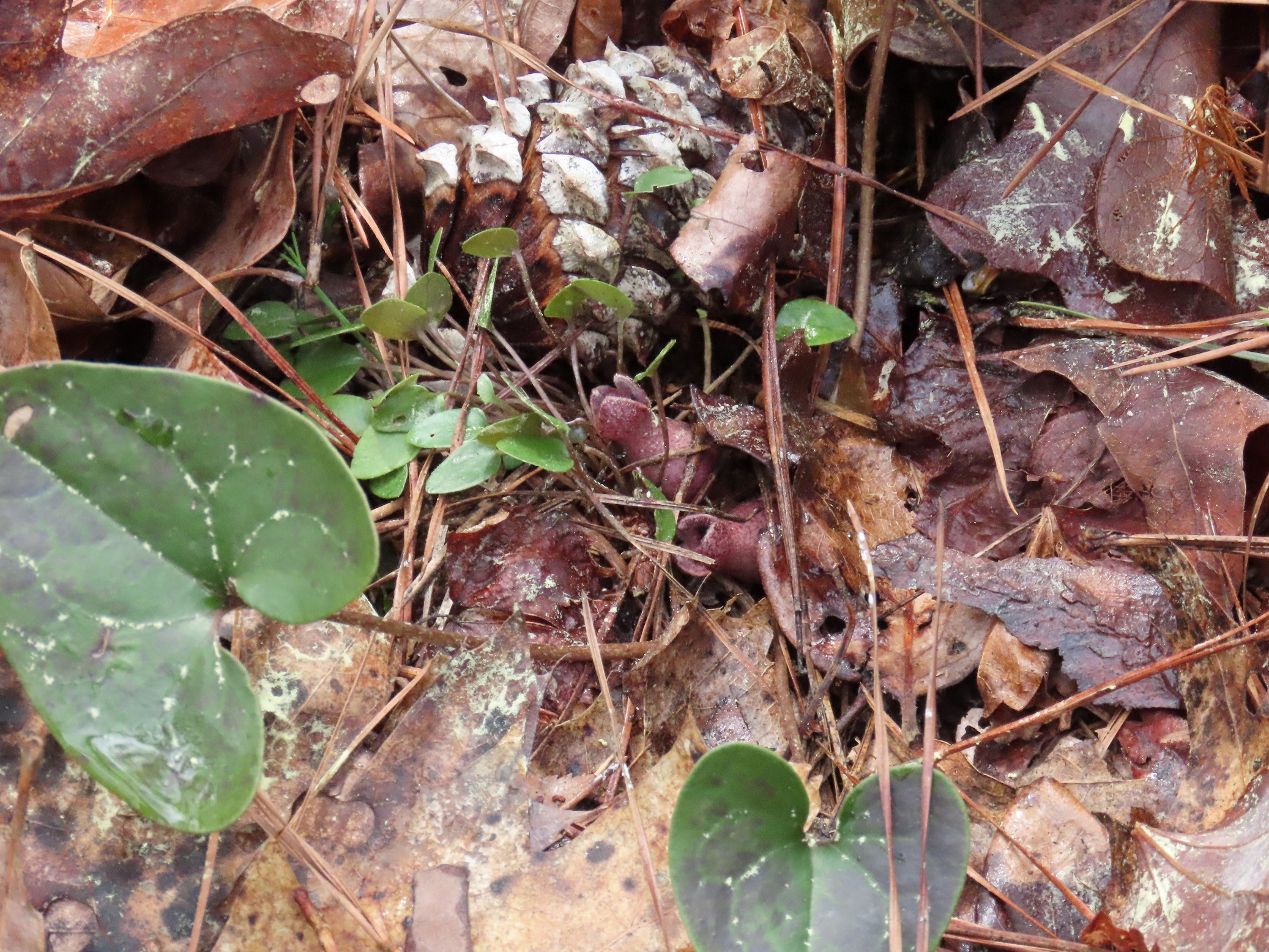
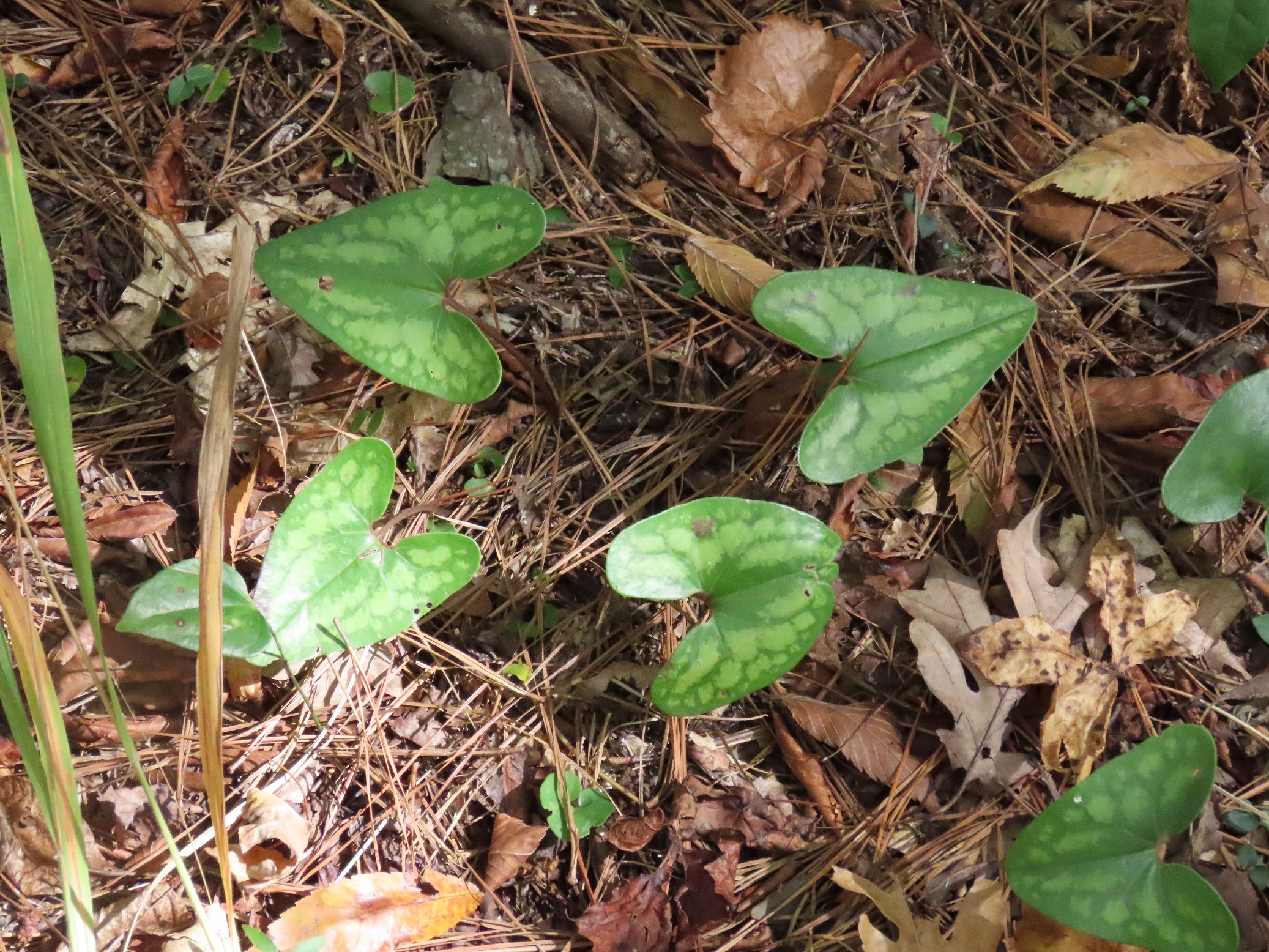
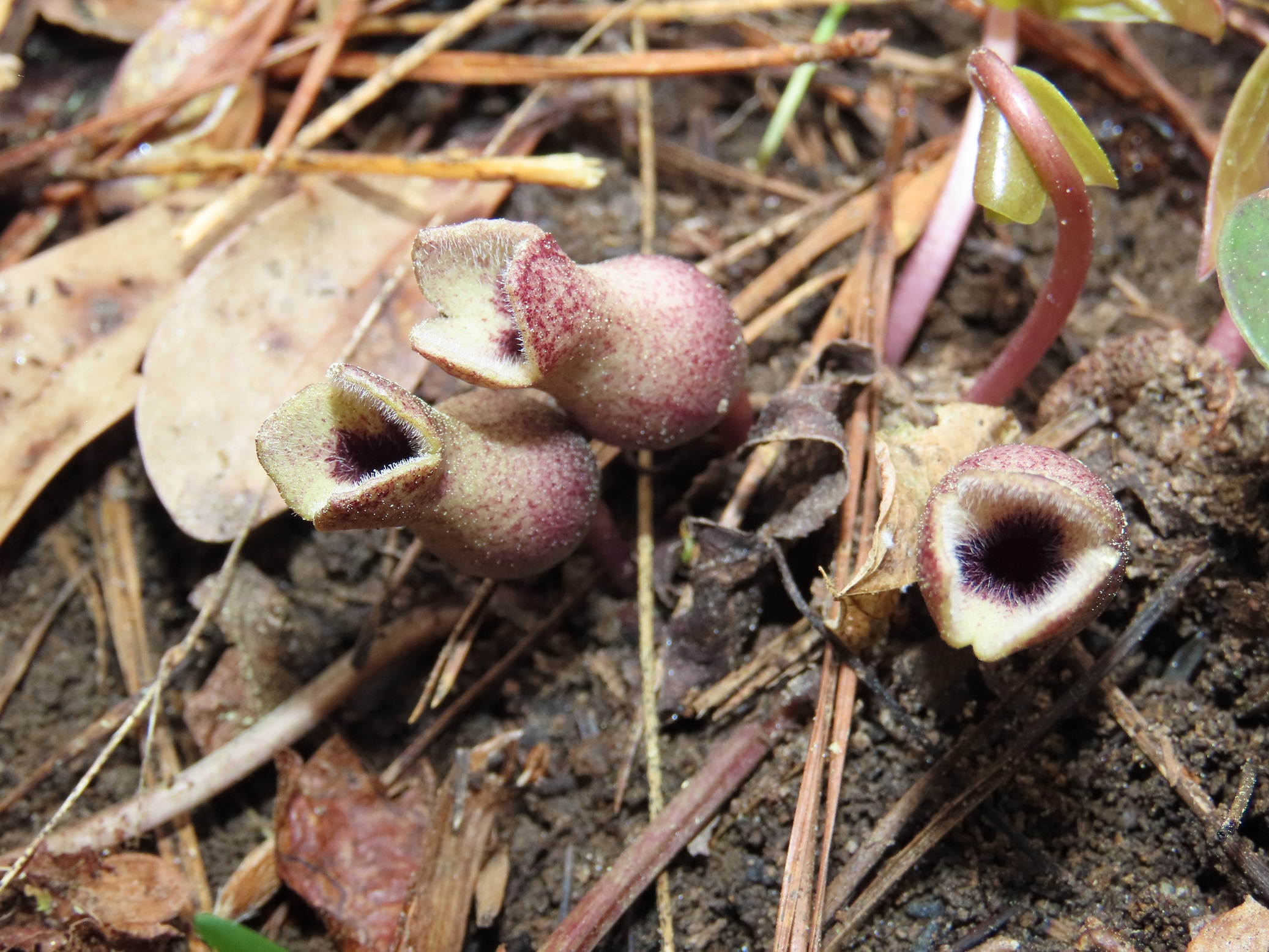
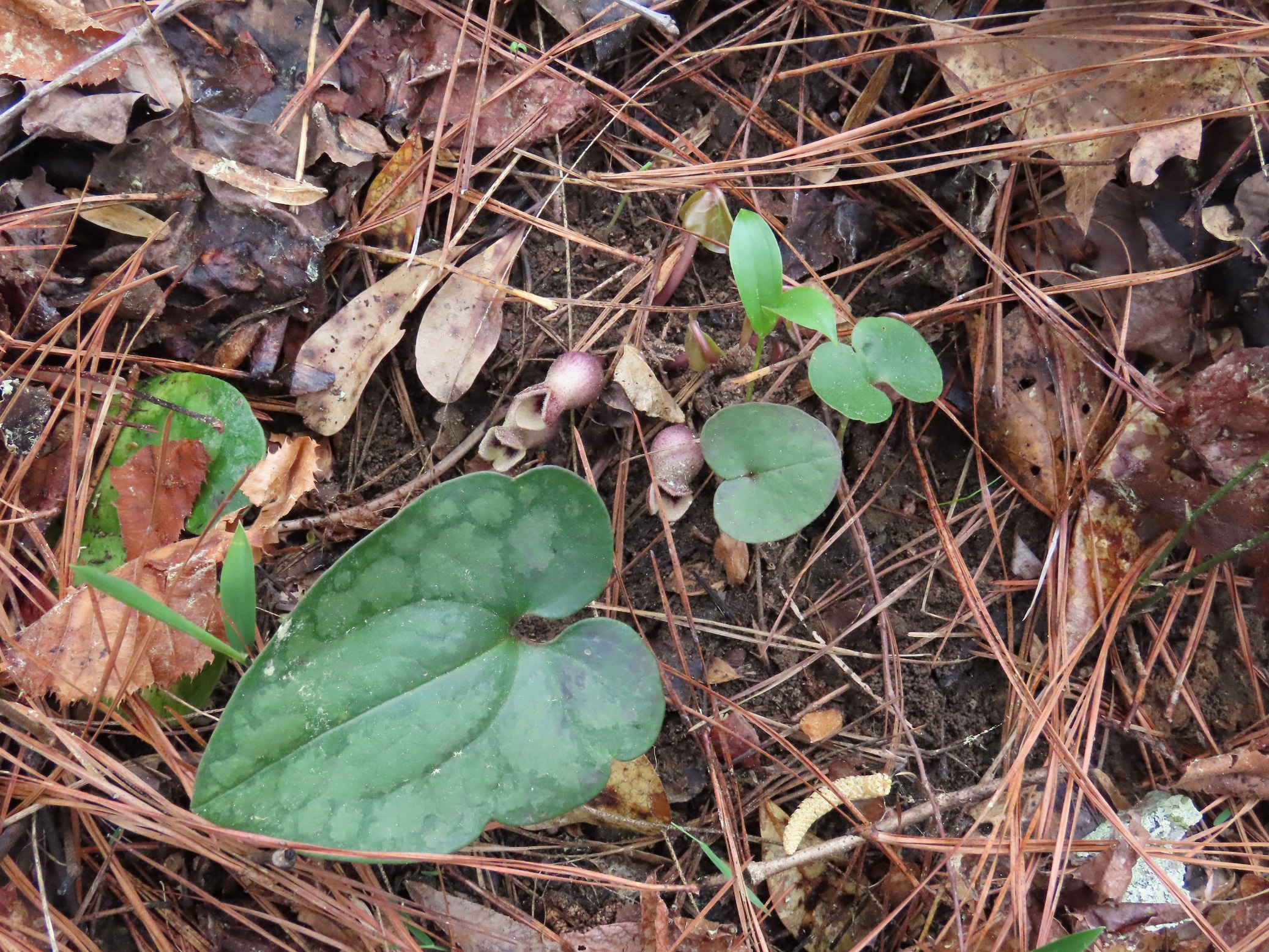
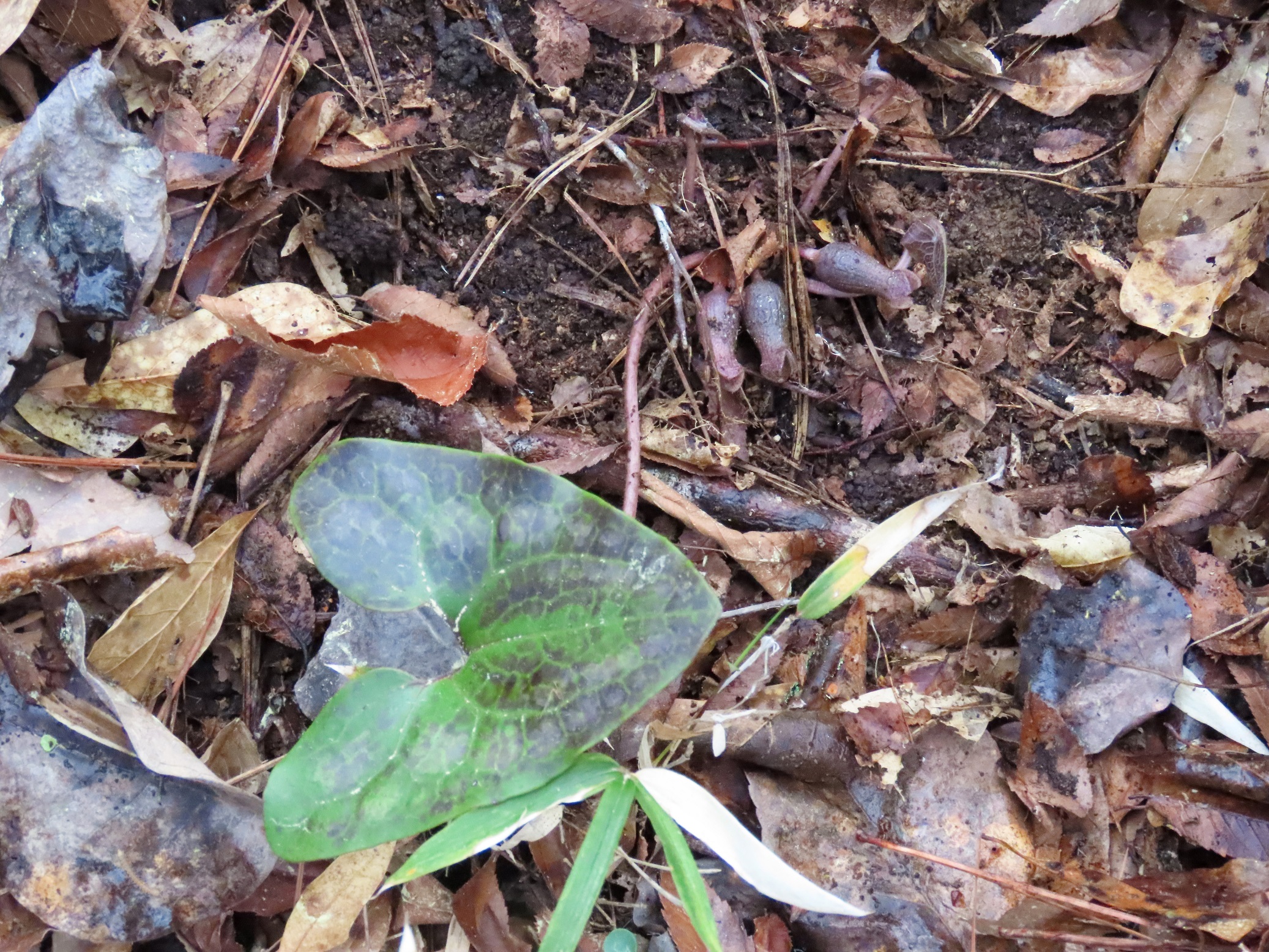
This week for Flora and Fauna Friday we have a relict plant of our wild past, Heartleaf Ginger, AKA Little-Brown-Jugs (Asarum arifolium).
Heartleaf Ginger is a common forest dweller in the Carolinas, increasing in abundance with altitude. Yet it still has a presence in every county of South Carolina. There are over eleven species of wild gingers found between South Carolina and North Carolina. But Heartleaf Ginger is the only species you’ll find here in the Lowcountry. Beneath the umbrella of a forgotten hardwood grove one can even find Heartleaf Ginger on Edisto Island, nestled between tree roots, draped over leaf litter, and smothered with heavy shade. Heartleaf Ginger needs deep shade on moist but well-drained soils to thrive and most often persists below undisturbed hardwood forests. Here on the Sea Islands, it’s quite scarce due to our flat topography, high water table, and our extensively intensive agricultural history. Meaning when you find a grove of Little-Brown-Jugs here, you know you’re standing in a special place. A relict of our original sea island ecology, trapped on an Island since the last ice age.
Heartleaf Ginger is a perennial plant with a leathery triangular leaf which varies in shape from heart to arrowhead. These leaves are about three-inches long, a dark jade-green, and often patterned with blotches of pastel-green in between the leaf veins. (If you find yourself botanizing in the Appalachians, these blotches between the veins help separate Heartleaf Ginger from its rarer mountain relatives, who have variegation along the veins.) Each leaf is held just above the ground on a short petiole, with the leaves emerging directly from the soil. Heartleaf Ginger can spread by its roots to create an evergreen groundcover in ideal conditions. Yet, it also has an interesting means of spreading by seed.
The flowers of Little-Brown-Jugs are, little brown jugs. It’s in the name. Well, they’re more like little mauve or burgundy jugs, but we’ll let it slide this time. Heartleaf Ginger is a member of the Pipewort family, Aristolochiaceae, which is a plant family with some strangely shaped tubular flowers. Heartleaf Ginger’s flowers are fairly tame for this clade, but still unusual among our Lowcountry flora. Each flower is an inch long urn with three lobes at the mouth. They’re colored dark-mauve to burgundy over a base of cream-white. These flowers crop up from the soil near the center of each leaf cluster, poking through the leaf litter or staying buried beneath it. There’s usually roughly one flower per leaf. These flowers are pollinated primarily by beetles, as well as ants, flies, and other minute insects. Their method for seed dispersal relies on insects as well, specifically ants. Little-Brown-Jugs seeds have a tiny nugget of fat attached to them that attracts certain species of native ants. The ants then carry the seeds back to their nest, where the seed germinates underground and a new Heartleaf Ginger plant springs forth.
Heartleaf Ginger is in the same genus as Wild Ginger (Asarum canadense). Both species were used by Native Americans and European settlers of Appalachia in folk remedies. Folks even used to flavor candies with Heartleaf Ginger. However, modern medicine has discovered that both species contain aristolochic acid, a trademark of the family Aristolochiaceae. This compound is carcinogenic and causes permanent kidney damage. Suffice it to say, this is an herb best appreciated by eye, and not by taste!
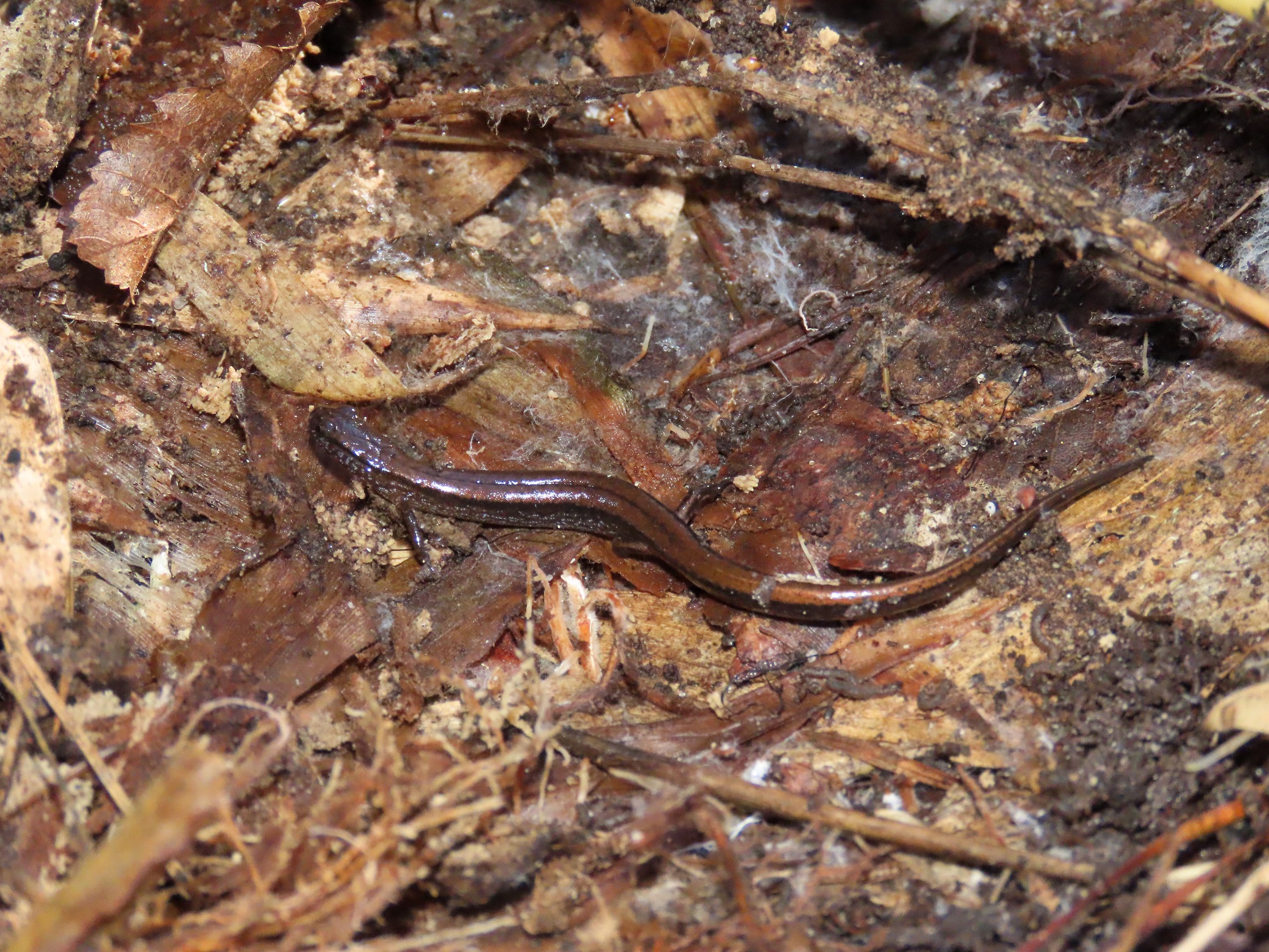


This week for Flora and Fauna Friday it’s our smallest salamander, the Coastal Plain Dwarf Salamander (Eurycea quadridigitata).
The Coastal Plain Dwarf Salamander is our smallest species of salamander here in the Lowcountry and one of our most abundant. They reside from the southern tip of North Carolina, throughout the Lowcountry of South Carolina, southern Georgia, and the panhandle of Florida. The Coastal Plain Dwarf Salamander has a sister species, the Chamberlain’s Dwarf Salamander (Eurycea chamberlaini), which was recently split off and is found in the midlands and foothills of South Carolina. The Dwarf Salamanders belong to the genus Eurycea, the Brook Salamanders, and are joined here in the Lowcountry by their congenerics, the Southern Two-lined Salamander (Eurycea cirrigera) and Three-lined Salamander (Eurycea guttolineata).
These four Brook Salamander species all share a common body plan, being small and skinny with short legs and a delicate head. The Dwarf Salamanders are best told apart by their small size, often only reaching two inches in length, and by only have four toes on their hind feet. Between the two Dwarf Salamander species, their diverging ranges are often sufficient for identification. But, in the hand, the Chamberlain’s Dwarf Salamander is often a straw-yellow in color. The Coastal Plain Dwarf Salamander by comparison is chestnut-brown along its back and flanked with sides of slate-gray peppered with flecks of quartz-white. Although a bit smaller, this Salamander’s shape and coloration are uncannily similar to our Ground Skink (Scincella lateralis), an abundant lizard in our Lowcountry forests.
The Coastal Plain Dwarf Salamander is found in a variety of shallow wetland habitats, from flatwoods and floodplains, to Carolina Bays, bluff seeps, coastal swale swamps, and even the margins of vegetated ponds and ditches. Here they spend their days worming through waterlogged leaf litter and squirming through Sphagnum capped seeps, hunting for miniscule invertebrates to devour. Like many of our salamanders and other amphibians, they lay eggs in the water, which hatch into, and spend the first several months of their life as, aquatic larvae before metamorphosing into more terrestrial adults. Dwarf Salamanders typically reproduce and lay eggs in winter, when water tables are highest in their wetland abodes.
I personally don’t associate salamanders with the Sea Islands. With our saltwater moats and three-hundred year history of intensive agriculture, which was followed swiftly by intensive coastal development on many islands, you wouldn’t expect for there to be much left in the way of salamander habitat. Especially for species sensitive to water pollution, temperature, and other environmental conditions, like the Brook Salamanders. And that is in fact the case. Yet, although few and far between, they’re still here! More terrestrial species, like the Marbled Salamander (Ambystoma opacum) and South Carolina Slimy Salamander (Plethodon variolatus), as well as fully aquatic species, like the Two-toed Amphiuma (Amphiuma means) and Sirens (Siren spp.), are more abundant and widespread. But in the untouchable backwaters and forgotten bogs, our delicate Dwarf Salamander still persists on Edisto Island.